2024 BUDGET BIKE ROUNDUP
Trek fuel ex 5 gen 5 review.
Words by Travis Reill | Photos by Dusten Ryen & Brian Niles Sponsored by Leatt & Tifosi Optics
With trail bikes in Trek’s lineup reaching five-digit prices, it is nice to see the industry giant offer a full-suspension trail bike that doesn’t break the bank. Trek was kind enough to send us the Fuel EX 5 to ride and review in our budget-bike shoot-out. At just under $2,500, the Fuel EX 5 is one of the most expensive bikes on test. We were excited to get the Fuel EX 5 out on the trails and see how it stacks up against the others in our test bike group.
• 130mm single-pivot ABP • Flip-chip adjustable geo • HTA 66.5 (high setting) • STA 75.5 (high setting) • REACH 475 (Large, high setting)
Big-brand Security
Highest Quality Frame On Test
WE DON’T
Short dropper post
Wide, Heavy wheels
Least Pedaling Support Of The Group

ABOUT THE TREK FUEL EX 5
Many of us are familiar with Trek’s trail-busting Fuel EX line. The Gen 6 Fuel EX saw added travel – not to mention a new frame design – but that doesn’t mean there isn’t room for the shorter-travel younger sibling out on the trails. With 140/130mm of travel and relatively moderate geometry, the Trek Fuel Gen 5 has been a trail bike many have reached for years.
FRAME AND FEATURES
Trek’s Fuel EX 5 features Alpha Platinum Aluminum. Trek boasts their aluminum “is continuously cold extruded and butted at multiple points, and hydroformed into sophisticated tube shapes for maximum strength and minimum weight.” The Fuel EX also has Trek’s Knock Block headset system, which prevents the handlebars from hitting the top tube and causing damage in a crash. Cables are internally routed, and the frame is offered in two color options: black, or the black and yellow we received.
The Fuel EX is offered in seven sizes, from XS to XL. X-small and small frame sizes come with 27.5-inch wheels and a pronounced dip in the top tube to help with standover height. Sizes medium and up are all equipped with 29-inch wheels. If you are familiar with Trek’s sizing, you will know that they also offer a medium/large size for those in between the two sizes. This is the only “in-between” size offered.
Trek’s Mino Link allows you to change the Fuel EX’s geometry. Switching from high to low will slacken the bike by 0.5°, drop the BB by 6mm, and shorten the reach by 5mm. While the bike comes with a 140mm travel fork, Trek gives allowance for bumping up to 150mm to improve descending capability.
The Fuel EX is essentially a linkage-driven single-pivot with one key difference—a pivot at the rear axle. Trek calls this their Active Braking Pivot (ABP) design. On most suspension designs, braking is considered to negatively impact the rear suspension’s ability to absorb impacts and provide traction. Trek’s ABP design aims to allow the rear suspension to remain more active under braking forces.
The Fuel EX 5’s geometry remains relatively moderate compared to today’s trail bike trends. For clarity’s sake, I’ll share the geometry in the “high” setting of the geometry-adjusting Flip Chip. The head tube angle is 66.5° and is paired with a 75.5° seat tube angle. The Stack Height ranges from 559mm to 623mm and Reach lengths range from 400mm to 500mm. Our size large came in at 609mm and 475mm respectively..
The BB height is 341mm in X-small and small, then 346mm for medium and up. Similarly, the BB drop is only 14mm below the axles on the two smallest sizes, and 28mm on sizes medium and up to account for the larger wheels. 436mm chainstays feature across all sizes. Our size Large Wheelbase totalled 1211mm.
BUILD SPECS
For the Fuel EX 5, Trek only offers two build options: a higher-end, 9.8 AXS Gen 5 and the budget-friendly EX 5 they sent us at $2,499. Leading the charge on our test bike was a Rockshox Recon Silver with the Motion Control damper and lockout. In the rear, there was a X-Fusion Pro 2 shock with “open” and “climb” positions.
The drivetrain is a complete Shimano Deore M6100 12-speed build, with Shimano’s 10-51 tooth cassette and a 30-tooth chainring. Shimano also handles the brakes, with 2-caliper hydraulic stoppers and 180mm rotors. 35mm width Alex MD35 wheels are laced to Bontrager hubs, and roll on wide 2.6 Maxxis Rekons. Bontrager makes up the rest of the build with tires, cockpit, and saddle—with the exception of a TranzX dropper post at a short 130mm drop length.
With a brand name as large as Trek, our expectations with the Fuel EX 5 were reasonably high. Even with a more budget-friendly component build, we figured Trek’s proven platform would shine through, regardless of the parts hanging from the frame.
When we tested the Trek Fuel EX 5 on the trails, we found it best suited for riders looking to put in miles. Its very moderate 66.5° headtube angle—the steepest of any of the bikes on test—puts the rider’s body more toward the front of the bike. This allows for a comfortable pedaling position, especially on climbs, which the Fuel EX 5 did reasonably well on. That forward-heavy position also provided good handling on the relatively techy bits of the climbs.
Even with a steeper headtube angle, the Fuel EX 5 wasn’t overly twitchy on faster descents. With 130mm of rear travel, it tackled some rough and chunky trails reasonably well, but finding its limit was quite easy for our aggressive riding crew. It also jumped decently, although the suspension had been firmed up quite a bit. This was done out of necessity, to add support to prevent harsh bottoming out on harder hits. Less aggressive riders looking for a more conventional light-duty trail bike may not feel the need to do the same.
One thing that seemed to hold the Trek Fuel EX 5 back while descending was the dropper post. Our size large EX 5 came with a 130mm dropper, a much shorter length than we’re used to for a size large frame. This meant having quite a bit less post insertion to get proper saddle height for climbing. When it was time to point the EX 5 downhill, the seat, even when dropped all the way down, was high enough between your legs to make handling the bike uncomfortable.
Initially, the expectation was that the Trek Fuel EX 5 might be the most efficient and best pedaling bike on test. However, we found that this wasn’t the case once we hit the trails. The bike’s geometry teased that as the case, but something seemed to be holding it back. After several of our testers spent considerable time on the Fuel EX, we concluded that the rolling weight of the wheels made the bike seem sluggish. We’re not sure why a trail bike is spec’d with 35mm inner width rims, but that, combined with 2.6 width tires, surely hurt the Trek’s performance when it came to rotational efficiency.
As with many of the other budget bikes in the field, the suspension and brakes were also where the Trek Fuel EX 5 came up short. The Fuel EX 5 shared the same suspension, and many of the same issues, as the GT Sensor Sport. The fork and shock both seemed sticky, and there were very few adjustments. The air pressure X-Fusion recommended for me (Travis) essentially turned the bike into a hardtail. When I let air out to get an appropriate SAG, the shock bottomed out hopping off a curb. Regarding brakes, the Shimano 2-pistons performed better than some of the other brakes on the budget bikes, but they still left us wanting a bit more power.
The Wolf’s Last Word
Price: $2,499.99 Website: Trekbikes.com
2024 BUDGET BIKE SHOOTOUT SPONSORS
Leave a comment, win free swag.
Want to win some free schwag? Leave a comment and vote up the most thoughtful comments and each month we’ll pick a winner. The person with the smartest and most helpful replies will earn some sweet new gear. Join the Pack and get the latest news and read the latest reviews on the top mountain and electric mountain bikes .

- Best Mountain Bike Reviews
Trek Fuel EX 5 Review

- Our Verdict
Our Analysis and Test Results
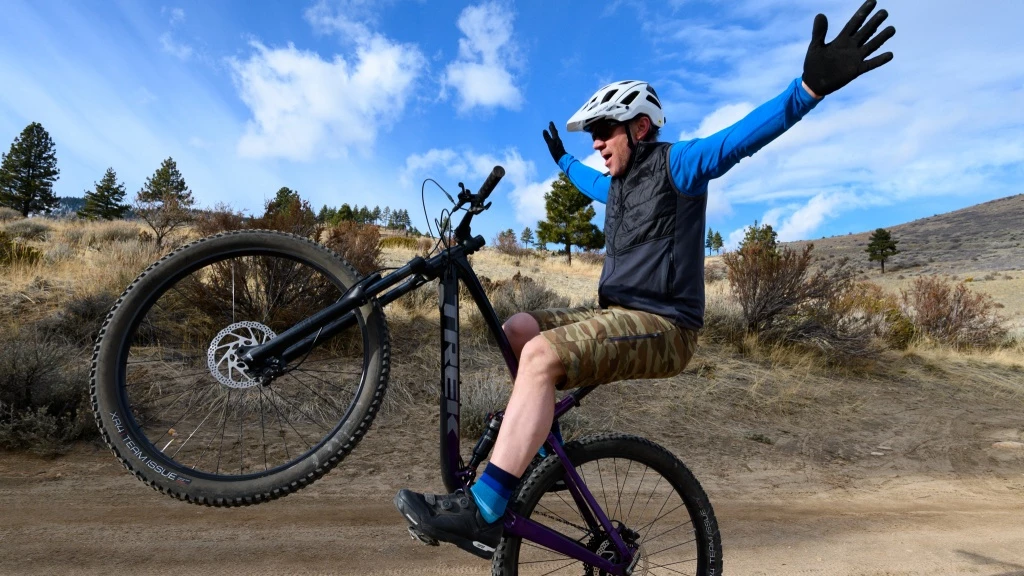
- Should I Buy This Bike?
Anyone just getting into the sport or operating on a tight budget would be wise to consider the Fuel EX 5 . Trek's 2020 redesign of the Fuel EX line made this bike more capable and well-rounded than the previous version with an updated geometry and rear suspension design. The geometry is modern without being over the top, and this bike's supple suspension feels great whether you're cruising mellow flow trails or rolling down a steep rocky section. It's a little on the heavy side and it feels a bit lethargic on the climbs compared to some of the competition, but it's comfortable and reasonably efficient nonetheless. While it was bested by the competition in this review, our testers were actually quite impressed with the overall performance of the Fuel EX 5. This is a killer bike at this price.
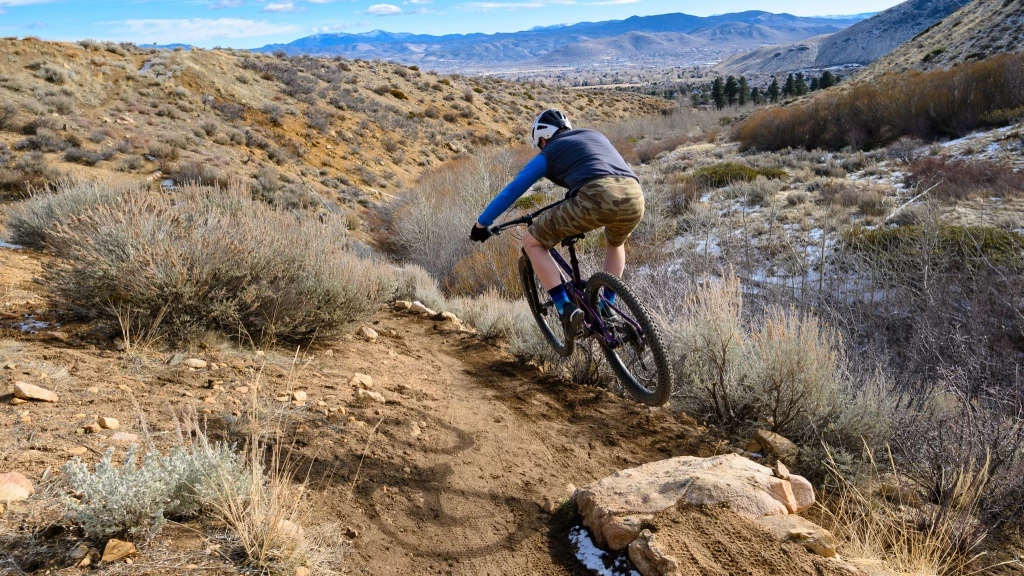
It used to be that testing bikes in this price range could be a little nerve-racking, but bikes like the Fuel EX 5 promote far more smiles and stoke than they did just a couple of years ago. This is thanks to modern trail bike geometry, and a thoughtful component spec that brings the performance of this entry-level model closer to that of the higher-end builds. Even our seasoned testers, all of whom are bike snobs with a preference for high-end models, had a blast while riding this relatively well-rounded and versatile mid-travel trail bike. It definitely has a preference for the descents, and it shines when pointed downhill with supple suspension, ample traction, and confidence-inspiring angles that don't hold you back.
The ABP suspension design of the Fuel EX is quite active, and it gives this bike a distinct trail-smoothing and ground-hugging feel, along with excellent stability on the descents. It's not the most lively or playful bike, but it flows down the trail comfortably with modern geometry that performs well on a huge range of terrain. The Fuel isn't an especially energetic climber, but it's competent, comfortable, and reliable enough on the ascents to get you back to the top for more laps or be a trusty companion on longer rides. Sure, there are a couple of components on this budget-minded build that we'd replace if this bike were our own, but this bike still punches above its weight class and is far more fun to ride than we'd expect at this price.

- Downhill Performance
The Fuel EX 5 is a smooth operator on the descents. This bike is stable, ground-hugging, and has supple rear suspension that feels great when gravity takes over. The geometry inspires the confidence to let it rip on the descents and it has a user-friendliness that makes it easy to get along with, and versatility to be fun on a huge range of terrain. Its 130mm of rear-wheel travel is paired with a 140mm fork, landing it squarely in the mid-travel category which is ideal for most riders.
When Trek redesigned the Fuel EX models for the 2020 model year they addressed the majority of modern trail bike geometry trends, making it longer and slacker than its predecessor. This has made the Fuel more capable than ever before and this bike can tackle anything you're willing to try and ride down. They also gave it flip-chip adjustable geometry, so the rider can change the head and seat tube angles by 0.5-degrees and raise/lower the bottom bracket height by 5mm. This is a nice feature to dial in the geometry to your preferences, though our testers found the low setting to be pretty ideal for everyday trail riding. When we measured our test bike we found that it had exactly the numbers we like to see these days. A 66-degree head tube angle, 470mm reach, and a 1210mm wheelbase seem to be about the sweet spot for a modern mid-travel trail bike. Throwing a leg over it, however, all of our testers noted that this bike felt smaller than other size large test bikes with similar measurements. That said, this bike's long wheelbase helps to make it very stable at speed while the 66-degree head tube angle helps make it feel confident rolling into steeper terrain.
Trek's ABP suspension design makes for a very supple rear end, and this bike has excellent small bump compliance and performance over high-frequency chop. The Fuel hugs the ground and smoothes the trail very well, though it doesn't give much support in the mid-stroke. Unfortunately, the ground-hugging suppleness of the rear suspension takes a little life and pop out of the rear end making this bike a little less playful than it could be. That said, it likes to mob downhill and it does it well, just with a little less flair than some of the competition. The RockShox Recon fork is also nice and supple and pairs well with the rear suspension, though on some bigger hits and blunt edges it will occasionally remind you that it's a budget fork.

Trek has outfitted all of the new Fuel EX models with dropper posts and wide tubeless rims and tires. This includes the EX 5 model we tested that came with 2.6" wide Bontrager XR4 tires. These tires have loads of air volume that allow for running lower pressures, as well as a versatile tread pattern that helped give it predictable cornering traction. Our testers love the fact that bikes in this price come with dropper posts, and the TranzX model on the Fuel is far better than nothing, but the 130mm travel length felt a little short on a size large frame. The cockpit setup is generally fine, but our testers would have preferred a handlebar wider than 750mm for muscling this bike around. Like many of the other bikes in this review, the Fuel EX 5 comes with Shimano MT200 hydraulic disc brakes. These brakes work fine and they generally handle the stopping duties reasonably well, but they feel a little underpowered for the speeds this bike can travel.
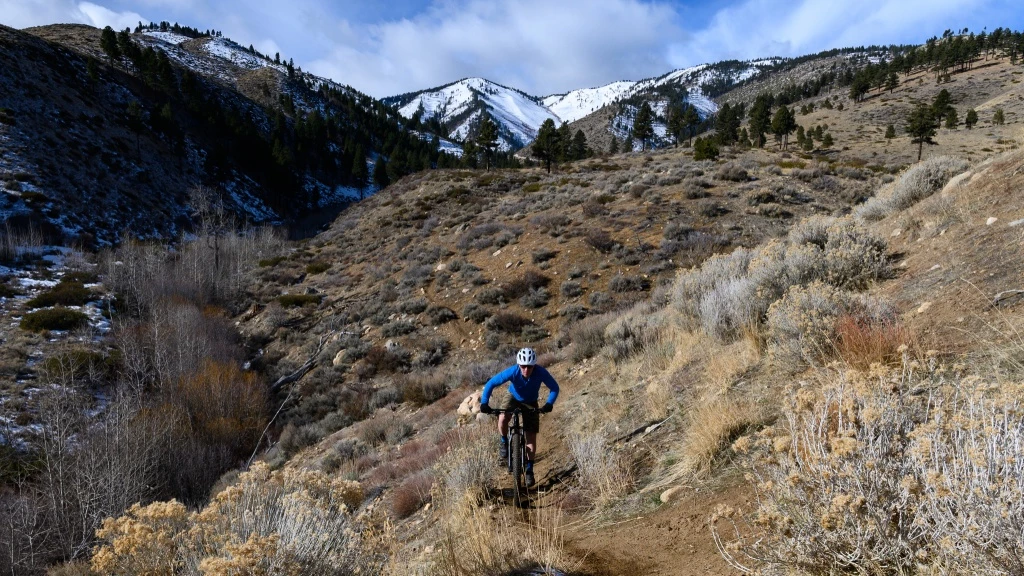
- Climbing Performance
The Fuel EX 5 is a relatively capable and comfortable going uphill, but climbing isn't this bike's strongest suit. It does just fine mind you, but it wouldn't be our first choice if we prioritized a quick or energetic feeling climbing experience. The geometry seems like it should be great, but it is held back a little by its weight, super active rear suspension, and some questionable components.
To be honest, the Fuel EX 5 climbs pretty darn well for a mid-travel bike in this price range, it's just bested on the climbs by some of the lighter weight and more efficient competition. It can manage just about any climb, it just has a somewhat lethargic feel to it due to its 33+ lb weight and super active rear suspension. The weight of this bike isn't terrible, but certainly noticeable when ridden back to back with lighter models. We're also fans of the Trek's ABP rear suspension design, although, without the RE:aktiv valving found on the rear shocks of their higher-end models, the EX 5 is a little more active in the back than we'd like. The pedal bob, when seated, isn't that bad, but it sucks the life out of any out-of-the-saddle efforts or short sprints uphill. Thankfully, the rear shock has a compression damping switch, which is very useful for climbing on any sort of road on this bike. In addition to the pedal bob, the Recon fork on this bike also had a tendency to dive when the rider's weight got forward. The Fuel EX 5 is best suited to less aggressive climbers who aren't racing anyone to the top of the hill.
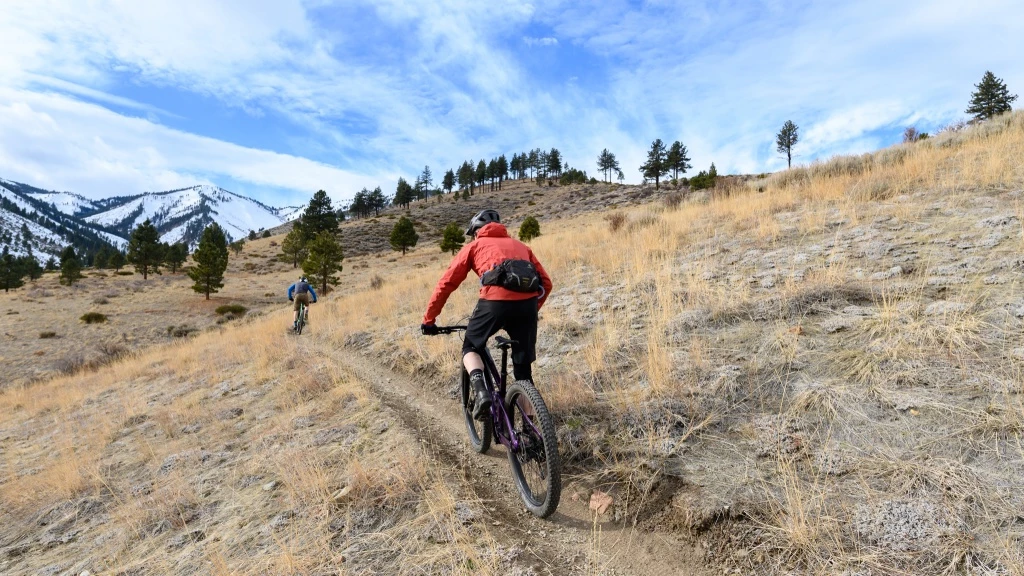
On paper, the geometry of the Fuel EX 5 seems totally dialed and in line with all of the modern trends. In practice, this bike feels significantly smaller and more cramped than those numbers suggest. Our taller testers wished for a larger frame size, and this was confirmed when we tested a higher-end model in an XL. If you're between frame sizes, we'd suggest taking a test ride if you can and possibly sizing up. That said, testers found the seated pedaling position to be generally comfortable, though the shorter reach resulted in a relatively upright and unaggressive stance. The steep seat tube lines the rider up above the bottom bracket and power is transferred straight down into the cranks. The 1210mm wheelbase sounds somewhat long, but again, everything about this bike felt smaller than it measured, and it was generally easy to maneuver in virtually any terrain. There is a flip-chip to adjust the geometry of the Fuel EX slightly, though our testers found the Low setting to be good for everyday trail riding. This bike also has a knock block headset that prevents the fork from contacting and damaging the downtube. Testers found it to limit the turning radius in super tight corners.
The build of the Fuel EX 5 is a mixed bag on the climbs. The 2.6" wide Bontrager XR4 tires are a high point with a huge contact patch and a tread that provides loads of traction in a range of conditions. Testers were less than impressed with the spec of a Shimano Deore 10-speed drivetrain. Sure, the shifting is crisp and reliable, but it simply doesn't have the range offered by the competitors with 12-speed drivetrains. There's nothing worse than trying to downshift and realizing you're already in your easiest gear.

The Fuel EX 5 's frame is made from Trek's Alpha Platinum Aluminum with 130mm of rear-wheel travel using the Active Braking Pivot (ABP) suspension design. The 2020 Fuel models have seen some changes to this rear suspension design, mostly that they now use a fixed lower shock mount as opposed to the full-floater design of years past. The frame has a knock-block headset, flip-chip adjustable geometry, internal cable routing, integrated downtube and chainstay protection, and a bottle cage mount within the front triangle.
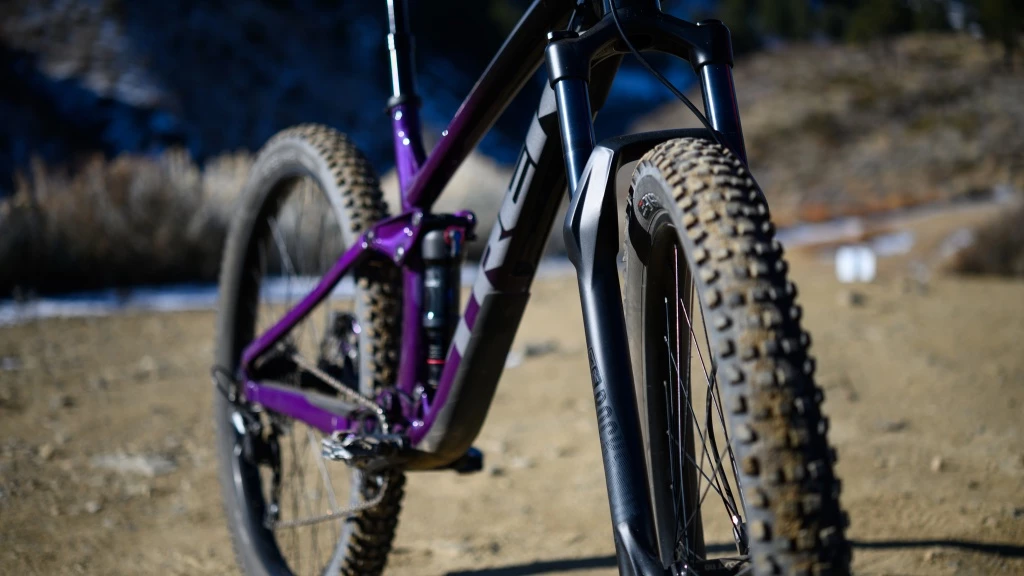
The 5 is the least expensive build in Trek's line of Fuel EX models, and the component specification reflects that. This is especially true of the suspension components, although they work reasonably well for the price. The 140mm of front wheel travel is handled by a RockShox Recon RL fork, the same fork found on several other bikes in this review. This fork works reasonably well and feels supple, though it can feel a bit flexy and harsh on bigger hits or high-speed chop. The RockShox Deluxe Select+ rear shock is a nice spec at this price point, and it feels especially supple paired with the ABP design on the rear end of this bike. It also has a compression damping/climbing switch, which was appreciated during long climbs.
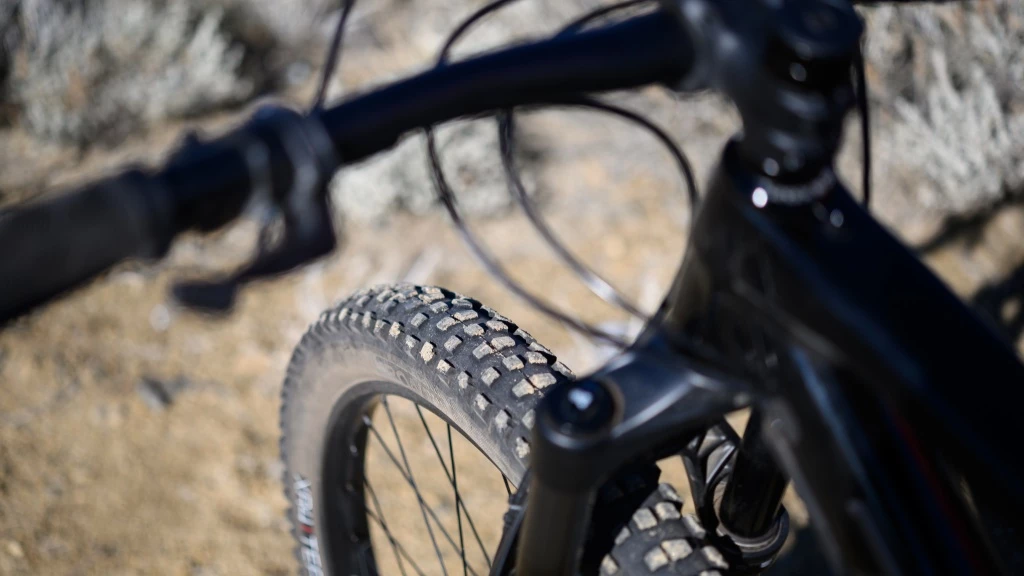
Trek has spec'd the entire Fuel EX line with wide tubeless-ready rims and tires, which is a nice touch. The 5 comes with a Formula front hub and Bontrager rear hub laced to Alex MD35 tubeless-ready rims with a healthy 35mm internal width. These wide rims pair quite well with the 2.6" Bontrager XR4 tires mounted front and rear. The XR4 tires are solid all-around tires with loads of air volume and plenty of traction on most surfaces. They have also proved to be more durable than our testers expected.
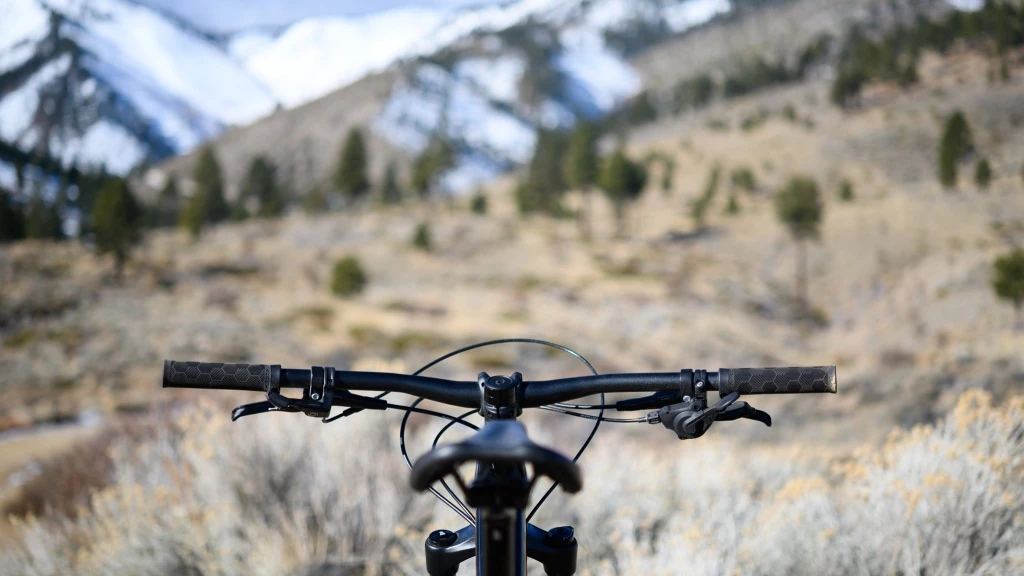
As with most bikes in this price range, Trek has spec'd the Fuel EX 5 with a bunch of house-brand Bontrager cockpit components. This includes the 750mm wide handlebar and 50mm Bontrager Rhythm Comp stem. The 750mm wide handlebar is a little narrow by today's standards, but testers didn't find it to be a detriment to this bike's handling. The 130mm TranzX dropper seatpost is far better than none at all, but testers felt that it was a little short for a large frame. The Bontrager Arvada saddle was okay, but it was far from the most comfortable seat we've experienced lately.
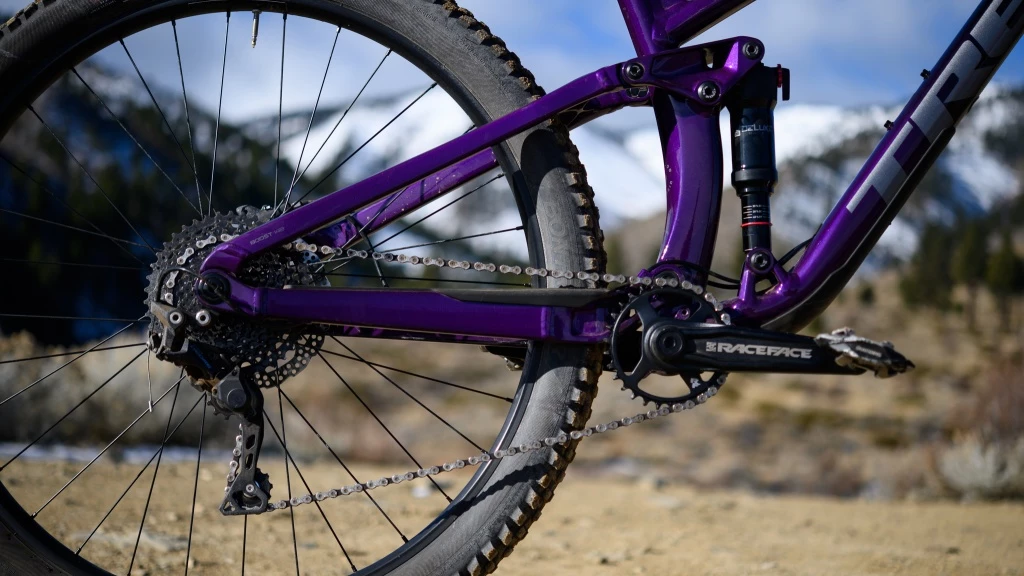
Trek is offering the Fuel EX 5 at a very reasonable price, and one of the ways they've managed to keep the price so low is by spec-ing a Shimano Deore 10-speed drivetrain. In this day and age, we are accustomed to 11 and 12-speed drivetrains, so this seems a little weak. That said, Shimano's 10-speed works reliably even if it doesn't offer as much range for steep climbs as the competition. As with many of the other bikes in this test, the Fuel comes with Shimano MT200 hydraulic disc brakes. They work, but they have a cheap lever feel, aren't especially powerful, nor do they offer much modulation.
Trek makes bikes for the masses, and with the Fuel EX 5 , they are offering a quality, versatile trail bike at an accessible price. Of course, $2,100 is still a chunk of change, but in a world where mountain bikes can cost upwards of $10K, we feel this is a great value. This is an excellent entry-level trail bike that would serve a lot of riders in a lot of locations very well.
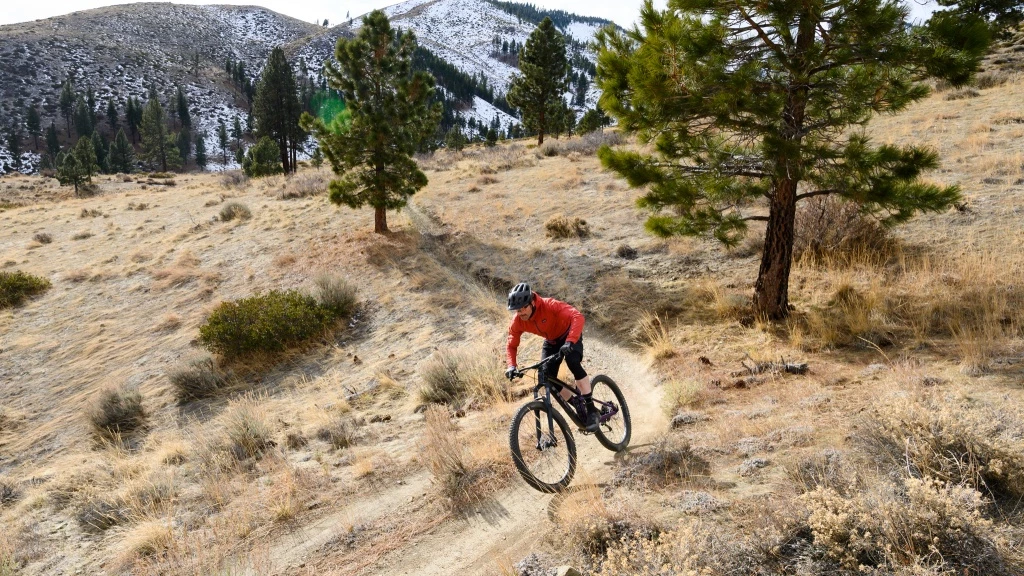

2023 Trek Fuel EX 5 Gen 5 Review
Are you looking for a high-performance mountain bike? The 2023 Trek Fuel EX 5 Gen 5 is the perfect choice.
This latest mountain bike in the Fuel EX lineup has been refined to perfection and comes with tons of great features.
The Fuel EX series from Trek has long been an industry standard as one of the most trusted mountain bikes on the market.

The fifth generation of these bikes has taken this legacy to the next level with its combination of cutting-edge materials, impressive technology and innovative design that makes it look and ride better than ever before.
This review will explore all of the aspects behind what makes the 2023 Trek Fuel EX 5 Gen 5 stand out and help you decide whether it’s the right bike for you. We’ll go in-depth into everything from performance to price, and show you exactly why this model is one of the best choices on the market.

The Trek Fuel EX 5 Gen 5 is an unforgettable new mountain bike that was released in 2023 and has already become the talk of the town!
This awesome bike features some of the most advanced MTB construction and components, providing a truly unique and thrilling experience for riders.
Read on to learn more about why this bike has made such a huge impact on cyclists everywhere.

The 2023 Trek Fuel EX 5 Gen 5 is the pinnacle of mountain biking performance with features designed to give riders unprecedented freedom and control on the trail.
It features an aluminum frame with light and stiff geometry, as well as a dropper seat post for tackling big climbs, mountain descents, and off-road adventures with ease.

The Fuel EX 5 also comes with a reliable 12-speed drivetrain and hydraulic disc brakes that are ideal for navigating technical sections in any weather. This bike was built to tackle any terrain – from gravel roads to singletrack trails – allowing you to explore farther than ever before.
– Lightweight Alpha Platinum Aluminum frame
– RockShox Recon Silver front fork with 140 mm suspension travel delivers added control on descents
– X-Fusion Pro 2 rear shock with 210mm of travel to cushion those huge drops
– Shimano Deore 1×12 speed drivetrain offers gearing options for all terrains
– 30t chainring bolted to a Shimano crank and paired to a 10-51t cassette
– Shimano MT200 hydraulic disc brakes perfect for reliable stopping power in any conditions
– TranzX dropper post takes your ride’s capabilities up a notch so you can take on challenging terrain
– Alex MD35, tubeless compatible wheels wrapped in either Maxxis Rekon EXO or Bontrager XR4 Comp tires provide superior trail feedback
– Sizes XS and S ship with 27.5″ wheels while the Medium and larger sizes ship with 29″ wheels

Rides Like A Racehorse
The Trek Fuel EX 5 Gen 5 is designed with a lightweight aluminum frame and full suspension which make it capable of ripping over rough terrain. It also makes for snappy handling, so you can get around tight corners quickly thanks to its agile geometry.

Versatile Yet Refined
Despite its impressive performance, the Trek Fuel EX 5 Gen 5 remains very user-friendly and simple to use. Its Shimano 1×12 drivetrain may only contain 12 gears but still offers an unbeatable range of gearing options, allowing you take on any type of trail or climb imaginable.
The long range Deore derailleur also offers crisp shifts with reliable accuracy even under pressure, while the hydraulic disc brakes offer accurate modulation control so you can slow down in style.

Smooth as Silk Suspension
Thanks to its full-suspension design, the Trek Fuel EX 5 Gen 5 gives you plenty of cushioning as well as unbeatable grip when riding over roots or rocks.
Further refining things is a RockShox Recon Silver air fork up front along with X-Fusion Pro 2 rear shock, offering 140mm and 210mm of travel, respectively, for great off-road responsiveness yet enough composure for fast XC sensations too.
Final Thoughts
In short, it’s easy to see why so many experienced mountain bikers have given the 2023 Trek Fuel EX 5 Gen 5 rave reviews recently.
It’s an insanely versatile ride that allows riders from all disciplines to enjoy blazing speeds combined with great control over varied trails and climbs.
If you’re looking for a no compromise bike that will perform at an incredible level whatever trail conditions come your way – this is it!
Order online and have it shipped to your local dealer for final assembly!!
Related Posts

2023 Cannondale Topstone 3 Review

Salsa Blackthorn SLX Review

2023 Cannondale Habit Carbon LT 1 Review

Trek Fuel EXe 9.9 XX AXS T-Type Review


- Rider Notes
2023 Trek Fuel EX 5 Gen 5

A 27.5″ / 29″ aluminum frame full suspension trail bike with upper mid-range components.
One of 99 Spokes Top 5 Affordable Trail Bikes
Manufacturer Price
Fuel EX 5 Gen 5
In Stock: SM, MD, MD/LG, LG, & XL
Fuel EX 5 Gen 5 - 2023, Small
In Stock: SM
Fuel EX 7 Gen 6 - 2023, X-Large
In Stock: XL
For This Bike
View more similar bikes →
Based on frame geometry and build specs.
A bike with lower gearing will be easier to ride up steep hills, while a higher top end means it will pedal faster down hills.
Similar Bikes
(descending)
Add custom gearing
Based on build material and quality level of the frame, fork, wheelset, groupset, suspension system, and more.

Jun 2023 · Tom Marvin
A solid performer with a class-leading chassis, let down by a harsh front end
Great frame, with perfect handling and suspension feel
Adjustable geometry and sizing options mean a bike fit for all
Happy on any level of trail
Cockpit harshness
Mediocre tyres
Poor brakes
Read Review

Jun 2023 · Scotty Prendergast
Arguably one of the all-time most popular bike models of any MTB on the planet, the ‘Fuel Ex’ has been at the peak of Trek’s MTB line-up for as long as anyone can remember and it has had no fewer than six major design overhauls during that time. Late last year Trek unveiled their newest reinvention of the ‘do it all trail bike’ which rolls out of the store boasting a ton of rider customisation features, including a choice of […]

Apr 2023 · Mike Kazimer
Kazimer's bike is set up with mixed wheels, a 160mm fork, and a coil shock.

Apr 2023 · Drew Rohde
While the new Trek Fuel EX may have alienated a few riders, it will no doubt be a welcome redesign for a lot more riders!
Fast, confident and ready to rock!
More capable than ever
Great downtube storage solution
Adjustable and versatile geometry options
Med/Large size
Bar/Stem combo
SE5 Tires in the wet
Some may not like the newer, burlier bike’s transition

All-new for 2023, the Trek Fuel EX is no doubt the burliest yet. How does it compare to the competition? Read on for our Trek Fuel EX review.
Sturdy, flex-free chassis
Superb geometry with adjustable head angle
Efficient & comfortable climbing performance
Coil shock, big fork & mullet compatibility
Mechanic-friendly frame furnishings
Internal storage
Frame is on the heavy side
Rear shock tune lacks small-bump suppleness
Rattly rear thru-axle lever

New geometry, more travel, and even better suspension improves Trek's mid-weight trail bike.

Trek's top-tier Fuel EX 9.9 XX1 AXS delights on the climbs and tackles downhill terrain with it's slack (and very adjustable) geometry.

Sep 2022 · Simon Kohler
With countless geometry settings and many sizes to choose from, the new 2023 Trek Fuel EX trail bike is supposed to be more versatile and customisable than ever.

Last updated July 11
Shop in-store for even more deals!
Shop in store for even more deals we can't advertise!
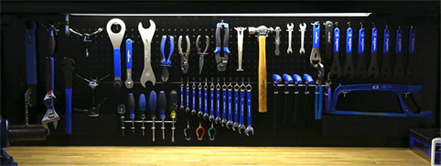
Mountain Bike Suspension Service
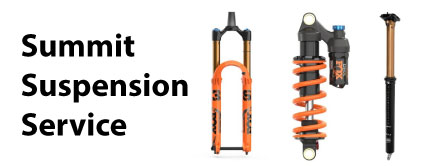
Trade In Your Bike

- Base Layers
- Mountain Bike Shorts
- Bibs, Tights + Knickers
- Mountain Bike Shoes
SAFETY GEAR
- Adult Helmets
- Youth Helmets
- Road Helmets
- Casual Wear
- Road Bike Shorts
- Bibs, Tights & Knickers
- Road Bike Shoes
- Accessories/Parts
Safety Gear
- Women's Helmets
- Road Bike Helmets
- Mountain Bike Helmets
WHEELS & TIRES
- Road Wheels
- Mountain Bike Wheels
- Mountain Bike Tires
- Wheels Accessories and Parts
- Derailleurs
- Chains & Cassettes
- Cranks and Chainrings
- Bottom Brackets
- Cables and Housing
- Power Meters
BRAKES & PEDALS
- Clipless Pedals
- Flat Pedals
- Mountain Bike Brake Sets
- Mountain Bike Brake Pads
- Road Bike Brakes and Pads
- All Brakes/Levers/Pads
Forks & Cockpit
- Grips and Bar Tape
- Rigid Forks
- Suspension Forks
Accessories
- Car Rack Accessories
- Electronics
- Front Lights
- Tail Lights
- Locks/Security
- Media/Resources
- Bicycle Mounted Racks
- Pumps/Inflation
- Tools/Maintenance
- Trailers/Strollers
- Trainers/Rollers
- Travel/Storage
- Water Bottles & Cages
Brand Guides
Bike buyer's guides, gear guides, new bike releases, summit bicycles online (855) 245-3663 [email protected] email, burlingame (650) 343-8483 [email protected] email, summit outfitters (408) 878-3252 [email protected] email, los gatos (408) 399-9142 [email protected] email, san jose (408) 264-2453 [email protected] email, palo alto (650) 304-0035 [email protected] email, summit bicycles mobile we'll come to you schedule mobile service today, (855) bike-one - for online orders and rental inquiries.
- Account Account
- Subtotal : $ 0.00 Checkout Cart
- Bicycling Catalog
- Full-Suspension
- Fuel EX 5 Deore Gen 5
Trek Fuel EX 5 Deore Gen 5
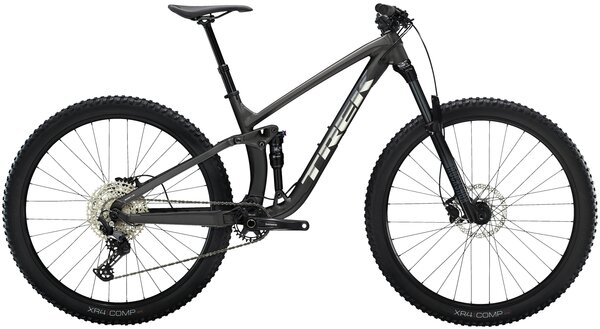
Fuel EX 5 is the gateway to full suspension trail bikes. Trail-taming front and rear suspension, a Shimano 1x12 drivetrain, a dropper post for getting low on descents, and hydraulic disc brakes make Fuel EX 5 a high-value, high-performance mountain bike with exceptional versatility. It's right for you if… You're ready to go full suspension, and you want a versatile trail bike at a great value. You want a ride that's sure-footed, capable, and responsive so you can stay in control no matter where you're riding. The tech you get A lightweight aluminum frame with a Knock Block steerer stop to protect against spinning bars. A 140mm RockShox Recon Silver fork, 130mm of rear travel with an X-Fusion Pro 2 shock, a durable 12-speed Shimano Deore drivetrain, dropper post, and hydraulic disc brakes. The final word You get full suspension performance without the sticker shock. Fuel EX 5 has the same frame technology as our higher-end alloy Fuel EX models with parts chosen to keep the price tag low and stoke level high. Why you'll love it: - You get a high-end ride at an exceptional value with frame features like Boost148 and ABP that give you confident handling and room to upgrade parts as your skills grow - It has the capability of far more expensive trail bikes: it shreds singletrack and can even handle the occasional XC or enduro race - The dropper post lets you lower your saddle on the fly so it's out of the way on descents - The RockShox fork's DebonAir spring can easily be adjusted for a specific rider weight, and it's lighter than a coil spring - We expanded our size range to ensure a better fit for all riders. And, you get the fastest wheel that fits your frame: XS frames get 27.5" wheels, S frames get to choose between 27.5" or 29", and sizes M to XL get 29" wheels
Geometry (27.5-inch Wheel Size)
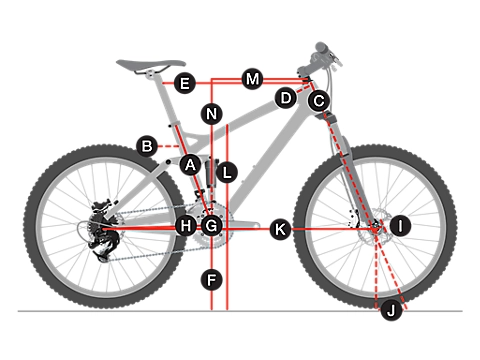
Geometry (29-inch Wheel Size)
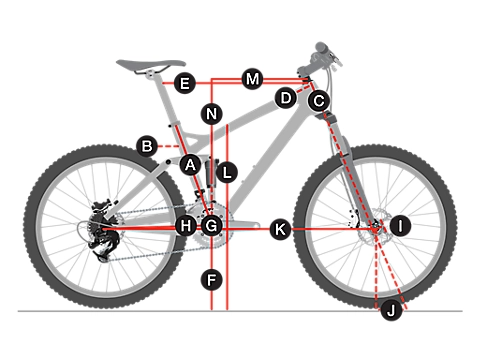
Will my bike have a curved top tube?

Smaller frames (XS and S) have a top tube that dips down as it approaches the seat tube. This design makes for a lower standover height, which is good for shorter riders because it allows them to straddle their bike more easily. Larger frames (M and up) have a straight top tube because taller riders with longer legs typically don’t have the same issues with standover height.
Due to supply-chain issues, Specs are subject to change without notice.
* Subject to change without notice.
Part Numbers

2023 Trek Fuel EX
Wheel Size: XS: 27.5’’; Small: 27.5’’ and 29’’ options; M through XXL: 29’’; all 29’’ frames also mullet compatible with a 160mm-travel fork
Travel: 140 mm rear / 150 mm front
Material: Aluminum and carbon fiber versions available
Sizes Offered: XS–XXL
- Aluminum frame w/ Fox Float X Performance: $2,600
- Carbon frame w/ Fox Float X Factory: $3,900
- Complete bikes $3,700 to $10,750
Blister’s Measured Weight: 33.1 lb / 15.0 kg (Fuel EX 9.8 XT, size Large)
Reviewer: 6′, 170 lb / 183 cm, 77.1 kg
Test Location: Western Washington
Test Duration: 4 months
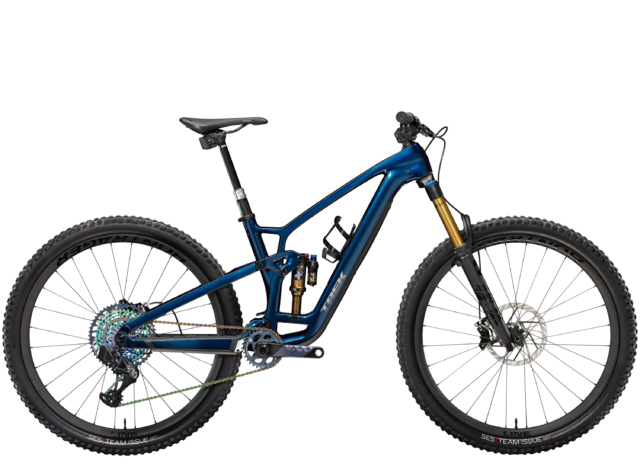
Trek’s Fuel EX has long been a popular all-round Trail bike, but the new version looks like a major departure from the bike it replaced, with more suspension travel, dramatically longer / slacker geometry, a ton of new adjustability, and a substantial cosmetic overhaul to go with it. There’s a lot to cover here, so let’s get right into it:
The sixth-generation Fuel EX includes loads of updates, starting with the wild amount of adjustability on offer. The prior-generation bike had a flip chip to toggle between two geometry settings, which the new bike retains, but it adds an optional offset headset that changes the headtube angle by +/- 1.0°, as well as a second flip chip that varies the amount of progression from the rear suspension — more on all that in a minute.
The overall aesthetic design of the frame has also been overhauled to match the new Fuel EXe lightweight e-bike, but Trek’s longstanding ABP suspension design carries over (now producing 140 mm of rear wheel travel, up by 10 mm from the outgoing bike), as does the option for aluminum and carbon frame construction. No matter which frame material you opt for, you get a storage compartment in the downtube, internal cable routing across the board, ample rubber guards on the seatstay, chainstay, and downtube, and a threaded bottom bracket shell. ISCG-05 tabs are also featured, and tire clearance is stated at 2.5’’. Trek’s sometimes-irritating Knock Block headset is nowhere to be found on the new Fuel EX. All sizes can fit a water bottle inside the front triangle, though the size of the bottle is limited on the smaller frame sizes.
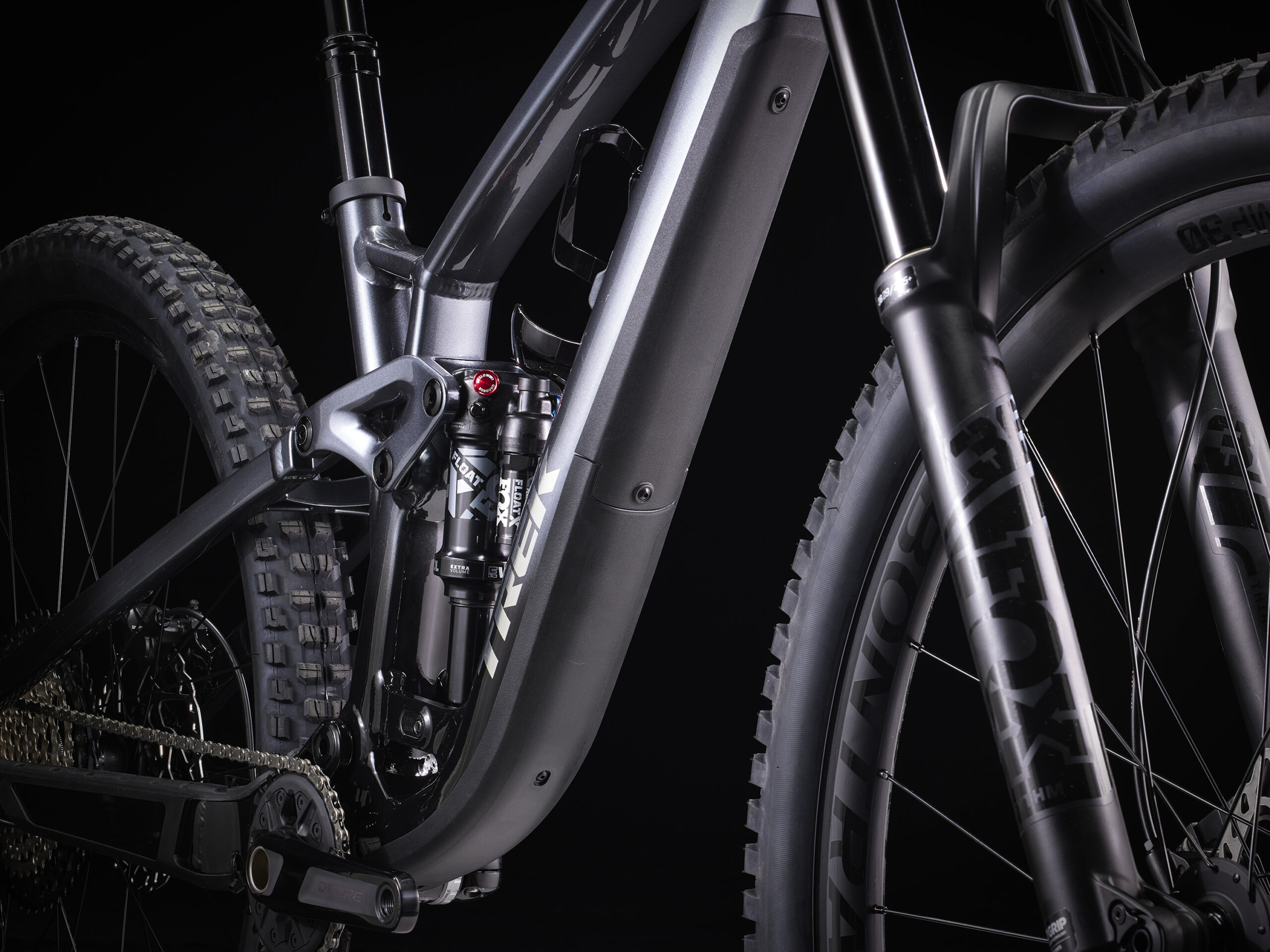
The Fuel EX now has a second flip chip that toggles between two different levels of rear suspension progression, which Trek amusingly simply labels “Less” and “More.” It’s essentially the same system that they introduced on the Session last year. In the “More” progression setting, the leverage curve goes from about 2.9:1 to 2.3:1 in a nearly straight line (~21% total progression); the “Less” setting drops the starting leverage ratio to about 2.75:1 (for ~16% overall progression), and the curve flattens off somewhat near bottom-out.
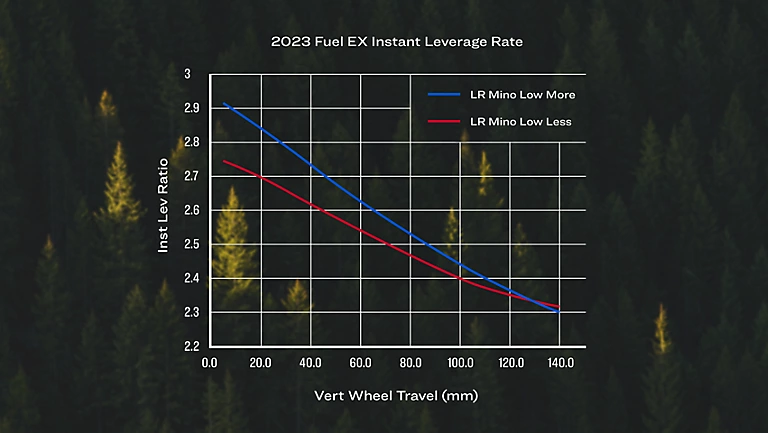
Fit & Geometry
Again, there’s a lot going on here — the new Fuel EX has a huge amount of geometry adjustability between the geometry flip chip (Trek calls it a “Mino Link”), optional offset headset (sold separately), and the option to run the bike with a 27.5’’ rear wheel for a mullet setup (on frame versions designed around a 29’’ front wheel). We’ll get to the full geometry charts in a minute, but to break down the highlights:
- Trek offers the Fuel EX in a whopping seven sizes (XS through XXL, with an “ML” size snuck in the middle). The XS frame is 27.5’’ only, the size Small comes in options for 27.5’’ or 29’’ wheels (each of which gets a dedicated frame — no converting back and forth), and sizes Medium and up are 29ers. All the 29er frames can be run as a mullet with the flip chip in the “High” position (and Trek recommends bumping up to a 160mm-travel fork to raise the bottom bracket a little).
- The headtube angle is 64.5° in what is probably the default position for most people (headset in the neutral position, flip chip in low, which is how Trek will ship the Fuel EX) but you can set it anywhere from 63.5° to 66° depending on how you mix and match the settings with the stock wheel size.
- Going to a mullet configuration on the 29er frames slackens things out to 63.9° in the neutral headset position; you can vary that by one degree in either direction with the offset headset.
- Reach ranges from 400 to 545 mm; all sizes get a 70.8° actual seat tube angle, with the effective measurement starting at over 78° on the smaller sizes and dropping off to 76° by the XXL.
- Chainstay length is 435 mm on the XS through M frames (irrespective of wheel size), 440 mm on the ML and L, and 445 mm on the XL and XXL.
Got all that? The geo chart for the “default” option (stock wheel size, headset in “neutral”, Mino Link in “low”) is below, and you can check out all the other configurations on Trek’s website.

Trek offers the Fuel EX in seven complete builds, and as a frame-only in both aluminum and carbon fiber — a welcome and increasingly-rare option these days. As per usual for Trek, all builds with a non-decimal number feature aluminum frames, while the “9.X” builds are carbon fiber.
[Trek is also continuing to offer the Fuel EX 5 with the prior-generation frame as the most entry-level offering in the range but here we’re covering the builds that are offered on the new sixth-generation frame.]
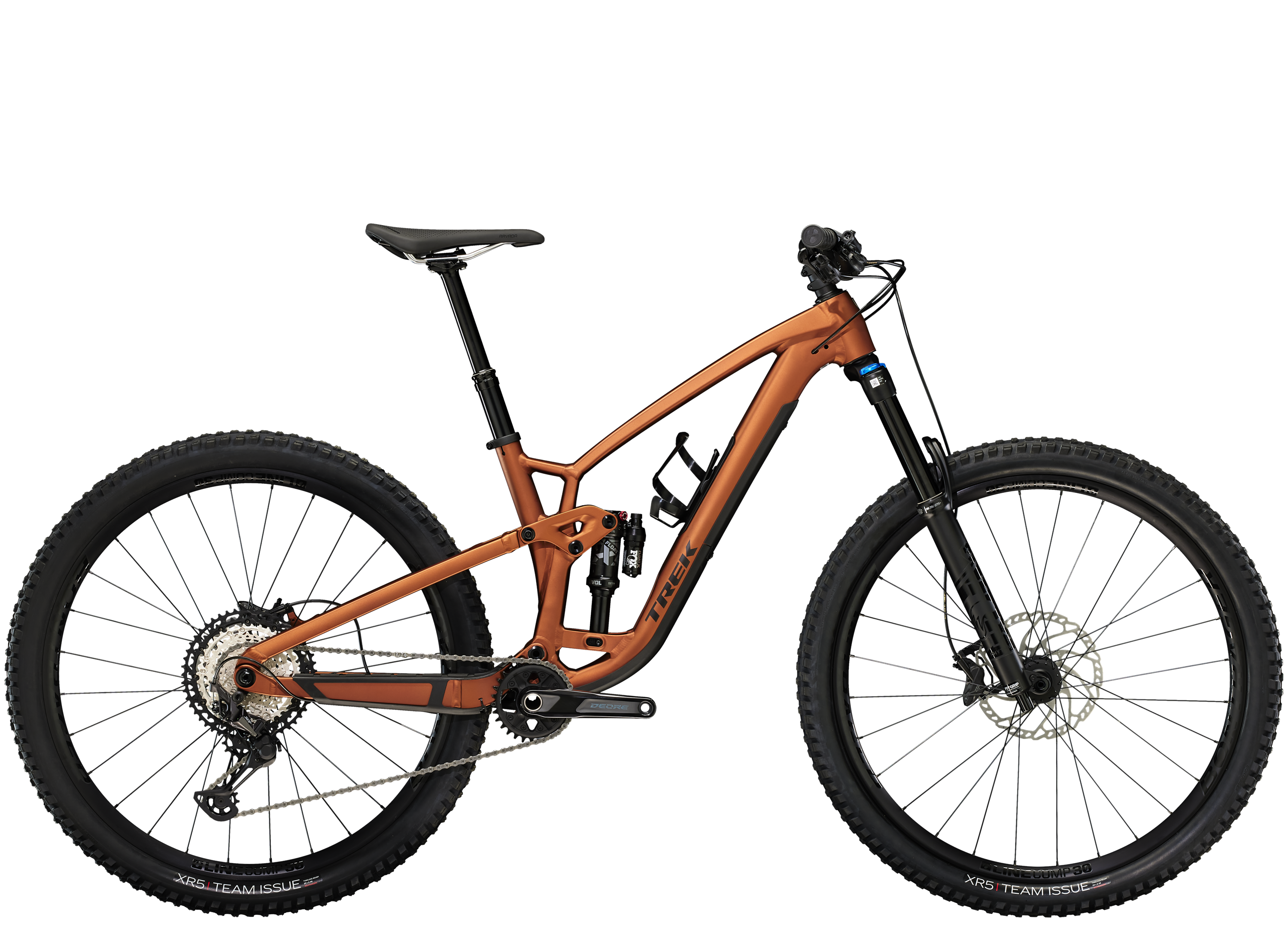
- Fork: RockShox 35 Gold RL
- Shock: Fox Float DPS Performance
- Drivetrain: Shimano SLX shifter, XT derailleur, Deore cassette
- Crank: Shimano Deore
- Brakes: Shimano MT4100 4-piston
- Wheels: Bontrager Line Comp 30
- Dropper Post: TransX
- Fork: Fox 36 Rhythm
- Shock: Fox Float X Performance
- Drivetrain: Shimano XT
- Brakes: Shimano M6100 lever / M6120 4-piston caliper
- Drivetrain: Shimano SLX w/ XT rear derailleur
- Brakes: Shimano M6120 4-piston
- Fork: Fox 36 Performance
- Crank: Shimano XT
- Brakes: Shimano XT 4-piston
- Wheels: Bontrager Line Elite 30 Carbon
- Dropper Post: Bontrager Line Elite
- Drivetrain: SRAM GX AXS
- Crank: SRAM GX
- Brakes: SRAM Code R
- Fork: Fox 36 Factory
- Shock: Fox Float X Factory
- Drivetrain: Shimano XTR
- Crank: e*thirteen TRS Carbon
- Brakes: Shimano XTR 4-piston
- Wheels: Bontrager Line Pro 30 Carbon
- Drivetrain: SRAM XX1 AXS
- Crank: SRAM XX1
- Brakes: SRAM Code RSC
- Dropper Post: RockShox Reverb AXS
Some Questions / Things We’re Curious About
(1) The old Fuel EX was looking a bit dated, geometry-wise, but that’s not the case with the new one, at all. So how does it stack up to a lot of the other good mid-travel Trail bikes we’ve been on recently, including the Santa Cruz Hightower, Guerrilla Gravity Smash, and Commencal Meta TR?
(2) And how does the wild adjustability of the new Fuel EX pan out on trail? Does it feel like a coherent total package across the range of options, or does it start to get a little quirky at the fringes?
FULL REVIEW
Trek has historically been a little on the conservative side when it comes to the geometry and design of their Trail bikes, so when the new sixth-generation Fuel EX launched last year, it came as a surprise — a 140mm-travel Trail bike that could go as slack as a 63.5° headtube angle, with wild new design language, and a ton of adjustability. Now having spent much of the winter and early spring on the new Fuel EX, it’s indeed quite adaptable and well-rounded — and a bike that we think could work really, really well for a lot of folks.
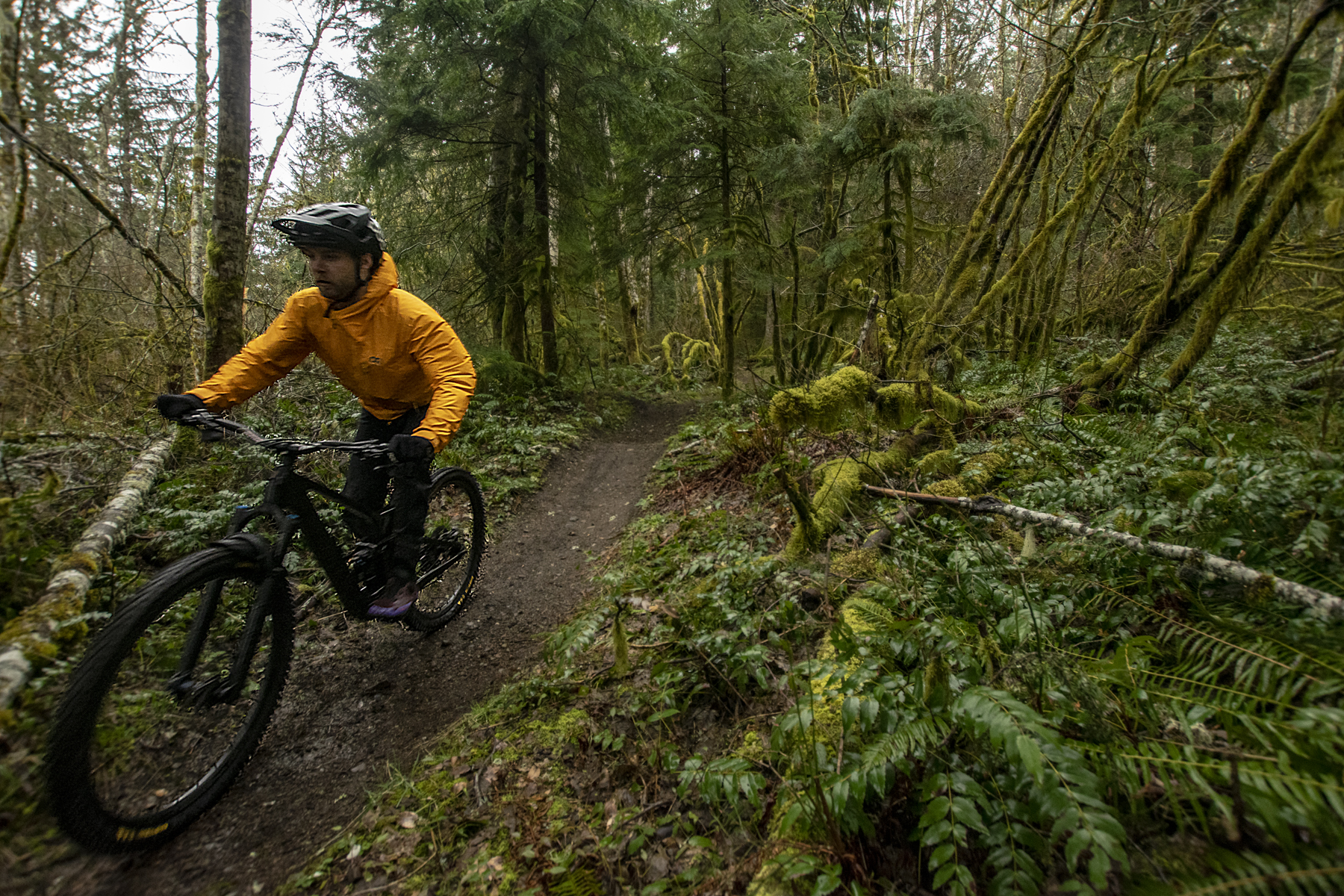
Fit & Sizing
Trek offers the Fuel EX in seven sizes — XS through XXL, plus an “ML” in the middle — but despite the huge size range and relatively tight steps between sizes (particularly around the middle of the range), Trek’s recommended sizing puts me (6’ / 183 cm tall) squarely on a Large frame, with no overlap onto the ML or XL sizes. And at least for my preferences and proportions, that was definitely the right call. I had an easy time getting comfortable on the Large Fuel EX — and with reach, stack, and effective top tube numbers that are all in my typically preferred range, that wasn’t a surprise.
Interestingly, Trek also lists a recommended inseam range on their sizing chart, and despite being at the bottom end of the range (at 33’’) for the Large frame, I had way more than enough room to swap in a 200 mm dropper post in place of the 170 mm one that came stock. Trek does put a 200 mm post on the XL and XXL frames, and I’m sympathetic to the idea that it’s arguably better to err on the side of shorter (so that you don’t have folks who need to swap the post to be able to ride their desired frame size — it’s easier to live with a shorter-than-ideal one than one that’s too tall, for sure). But I wanted a 200 mm post, and I bet a lot of folks on the Large frame will feel similarly.
The Fuel EX’s massive geometry adjustability is much more focused on handling and ride characteristics than fit, and my overall take on fit and sizing didn’t really change much across the range of options (which I’ll cover in a lot more detail below). There are, of course, changes to the reach, stack, and effective top tube as you tweak things via the Fuel EX’s built-in geo adjustments, but they weren’t dramatic enough to change my assessment of the overall fit. The one slight caveat there is the stack height — the Fuel EX’s is a little on the shorter side, and the high flip chip and/or slacker headset settings both reduce it a little more. It wasn’t so short as to cause me real problems getting the fit sorted out, but I did need to swap in a higher-rise bar to help out, particularly in those lower-stack-height configurations to get things high enough — but as I’ll explain below, I wasn’t a fan of the stock bar and stem anyway, rise considerations notwithstanding.
A lot of Trek’s Trail / Enduro bikes in recent years — including the prior-generation Fuel EX — have skewed more toward the compliant, grippy end of the spectrum at the expense of some efficiency and snappiness under power. The new Fuel EX flips that around. It’s quite an efficient, quick-feeling bike under power, but does a notably good job of keeping a solid chunk of the ultra-planted, grippy nature of the earlier iteration — and again, that’s despite the new Fuel EX gaining 10 mm of travel at both ends.
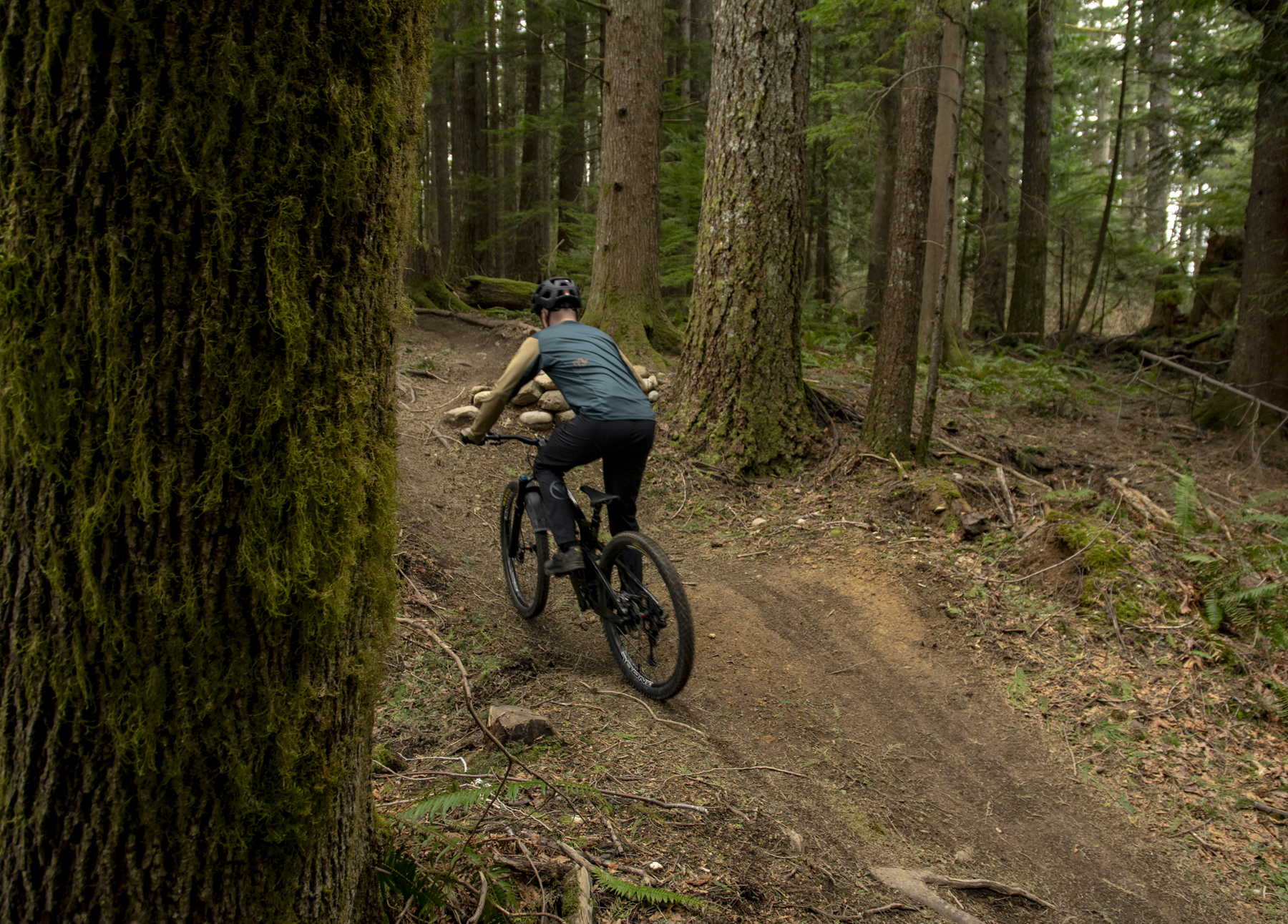
That’s not to say that the Fuel EX is way off the end of the spectrum in terms of efficiency or anything like that, but I’d put it a solid notch above average for a 140mm-Travel trail bike, and it pulls that off while still being entirely respectable when it comes to grip and compliance under power. It’s a really nice recipe for a well-rounded, versatile bike, and while folks who specifically loved the ultra-plush feeling ride of the earlier Fuel EX might feel like the new one has lost a little bit of the magic, I think the new Fuel EX’s suspension performance under power feels more coherent for the bike’s intended use and is going to work better for more people.
In terms of low-speed handling and technical climbing prowess, the Fuel EX’s wildly adjustable geometry makes it a lot harder to give a concise single answer as to how it performs. I’m mostly going to focus on the neutral headset setting since that’s how the bike ships, and I think it’s how most folks are going to run the Fuel EX (and for what it’s worth, it’s also how I preferred to run things), but I’ll touch on the geometry settings and how they change things in more detail below.
Anyway, around the middle of the range of geometry settings, the Fuel EX’s low-speed handling feels quite intuitive and easy but biased a little more toward offering a big sweet spot that makes it easy to keep both wheels planted and gripping, at the expense of a bit of agility at really low speeds, especially as compared to the prior-generation Fuel EX. The new one is still a pretty good technical climber and feels a lot easier to just sit on and grind without having to work to keep the front wheel planted on really steep climbs, but also isn’t quite as easy to snake through really tight spots. Running the steeper, higher geometry settings speeds up the low-speed handling and adds to pedal clearance in really chunky sections but, of course, comes with tradeoffs in higher-speed descending performance. Again, more on the various geometry settings below.
But overall, I think the Fuel EX is an excellent climber for a 140mm-travel Trail bike. The pedaling position is well sorted, striking a nice balance between a steep-ish seat tube without going so far down that road as to feel awkward pedaling around on flat ground. The suspension feels efficient first and foremost but still offers good traction for that level of efficiency and pep under power, and its handling at lower speeds is predictable and intuitive. It’s quite good, especially if you’re inclined to favor a slightly more efficient pedaling platform over the most compliant and grippy suspension performance under power, but the Fuel EX is overall well-rounded and should suit a lot of people nicely.
On the way back down, the Fuel EX is, again, a really well-rounded, versatile bike that feels at home on a fairly wide spectrum of trails. Its massive adjustability (more on that later) doesn’t hurt either, but I don’t think that most folks are going to be toggling between different settings all that often — rather, I think they’re more likely to find a preferred combination and stick with it.

But especially in the middle part of the settings range (as I’ll explain more below, I found the low flip chip / neutral headset setting to be my personal favorite), the Fuel EX strikes a nice middle ground where it’s solidly stable at speed for a 140mm-travel Trail bike but doesn’t feel like it gives up a huge amount of agility to get there. It’s not the absolute quickest handling ~140mm-travel bike in very tight, super low-speed spots, but can still navigate them just fine, and once you’re moving just a little bit, the Fuel EX’s handling feels super intuitive. Its sweet spot in terms of preferred body positioning is notably wide, especially for what is not a wildly long bike overall, and the Fuel EX hits what I think is a really nice blend of being simultaneously moderately stable while also being reasonably quick handling when you need it to be.
And especially in the lower geometry flip chip setting, the Fuel EX corners really, really well. It offers a combination of having a big sweet spot and a lot of room to move around on the bike — in a way that I tend to associate with longer, more stable Enduro bikes — but does so without being as much work to muscle around as those sorts of bikes; this serves the Fuel EX especially well there. It’s not the absolute easiest bike when it comes to slashing the rear end around and oversteering all over the place, but it’ll do that with a little input, and really shines if you’re more inclined to load up the bike through the pedals and carve your way through corners.
The Fuel EX also feels notably plush and cushy in terms of its suspension performance. As I’ll get into more in the section on the build, below, I think a lot of that is down to the rear shock tune as opposed to anything inherent to the frame itself, but the Fuel EX offers a ton of rear-wheel grip over smaller chatter and doesn’t need to be going very fast or hitting stuff hard for its suspension to open up and feel very forgiving and comfortable. The flip side of that is that I did feel like the stock suspension was a bit quick to blow through the middle part of its travel when speeds picked up, especially in choppy, high-speed sections with a lot of sharp mid-sized hits. I’ll grant that this mostly showed up when I was riding the Fuel EX on trails that most folks break out a bigger Enduro bike for, and that I tend to favor firmer compression tunes and more support over the absolute maximum grip and compliance. So I think a lot of folks will be fine with (or specifically psyched about) the lighter compression damping. But it does feel notably light, especially at higher shaft speeds.

While this doesn’t quite fit cleanly into the “Climbing” or “Descending” categories, the Fuel EX really shines in rolling, varied terrain with a bunch of grade reversals and short ups and downs. I’d attribute this to its combination of (1) good pedaling efficiency for those punchy climbs, (2) well-balanced handling with a huge sweet spot in terms of body positioning that helps avoid getting caught out when the bike hangs up in an awkward spot, and (3) notably good traction and suspension compliance at lower speeds, when you’re not able really load up the bike to generate that grip. And while there are a lot of bikes out there that I’d say similar things about — the Santa Cruz Tallboy comes to mind — what sets the Fuel EX apart is that it’s more stable and capable when you point it down a longer, steeper descent than most of the (generally more compact, shorter-travel) bikes that I’d put in a similar camp on the rolling, punchy trails.
Adjustability
The large amount of geometry adjustability on the Fuel EX is an interesting part of the story of the bike. In short, I think Trek has done a good job of offering a host of adjustments that make substantial differences to how the bike rides, without making the range of settings so broad as to make it easy to wind up in a weird combination that rides poorly.
The two flip chips (a.k.a. “Mino Links” in Trek’s parlance) do about what you’d expect. The low setting makes the Fuel EX feel a little more stable at speed and a little slower handling in tight spots, but the bigger difference is that it puts the rider noticeably lower in the bike — eight millimeters of bottom bracket height is quite a bit — and results in feeling more “in” the bike, particularly in higher-speed corners, at the expense of some pedal clearance and some ease of initiating corners by leaning the bike over with more modest input. The “More” progression setting on the Mino Link (which, again, is separate from the geometry-adjusting one) makes the suspension ramp up a little more aggressively and feel more supportive deep in the travel than the “Less” progressive setting, but that difference is comparatively modest.
I also experimented with the optional offset angle-adjusting headset (which is sold separately for folks who want it) and those results were similarly as expected — slackening the headtube made the Fuel EX more stable at the expense of some nimbleness at lower speeds and also required a slightly more forward weight bias to keep the front wheel gripping properly; going steeper makes the low-speed handling quicker but diminishes the Fuel EX’s stability and composure when you start going faster.

I think Trek has done a nice job of working out adjustment ranges that make a real difference in how the bike rides without going so off the deep end as to introduce particularly quirky behavior at the ends of the spectrum, but I had the hardest time with the steeper headset setting, because the chainstays started to feel a bit long relative to the front-center of the bike. In that configuration, the Fuel EX both preferred a more centered, upright body position to not get too far out over the front end and felt like its sweet spot got substantially smaller. Folks who specifically want a very quick-handling ~140mm-travel Trail bike might still find something to like here, but I think the vast majority of people for whom the Fuel EX is a generally good fit are going to be best suited by the stock neutral headset position. And indeed, for the bike’s intended use, the neutral headset, low / more progressive Mino Link arrangement was my preference most of the time.
Though I don’t think all that many people really need to worry about it, I’m still a fan of the fact that Trek offers a clean, easy-to-use offset headset for the bike for the tinkerers out there. The lower cup does require a headset press to install, so it’s not a super quick-and-easy change that many people are going to want to do often, but it’s not hard to do a couple of times to experiment, and the drop-in top cup never gave me any issues with creaking or anything else.
I also tried a mullet configuration on the Fuel EX briefly, but only in the neutral headset position and with the fork still at the stock 150 mm of travel, rather than the 160 mm configuration that Trek recommends. As per usual for bikes that can toggle back and forth, the mixed-wheel layout made the Fuel EX feel a bit quicker handling (particularly in mid-speed corners), a little less stable in a straight line, and made the rear end feel shorter and easier to slash around. None of those differences were huge, and I personally got along better with the full 29’’ setup (as tends to be my preference) but the Fuel EX feels like a very viable mullet candidate for folks who are inclined to go that route.
The Build & Frame
I reviewed the Fuel EX in the mid-range 9.8 XT build, and for the most part, it’s pretty nice. The Shimano XT drivetrain and brakes are great, and this pair of brakes didn’t give me much trouble with wandering bite point, as is often an issue on Shimano’s brakes in general. Carbon wheels are a rarity at this price point ($6,250), and the Fox 36 / Float X suspension combo is solid, too.
But at least for my preferences, I found the compression tune on the rear shock to feel pretty light, particularly in terms of higher-speed damping. The stock shock feels quite plush and cushy when you start hitting things harder, but gives up more support and composure than I would have preferred, particularly in high-speed, choppy sections of trail. I spoke with Trek about my thoughts re: shock tune, and their response was that they tuned their shocks to work as well as possible for as big a swath of the riding public as they could manage, but that there are inevitably tradeoffs in trying to cater to riders across a range of weights and ability levels — and they’re certainly right about all of that. My take is simply that the Fuel EX’s shock tune feels oriented more toward the lighter-damped, more plush end of the range, and that’s absolutely going to be the right call for at least some folks. Heavier / more aggressive riders, or those who just know that they tend to like firmer compression damping might just need to plan on a shock upgrade or re-valve to get the damper support that they want out of the Fuel EX, and I’m personally in that camp.
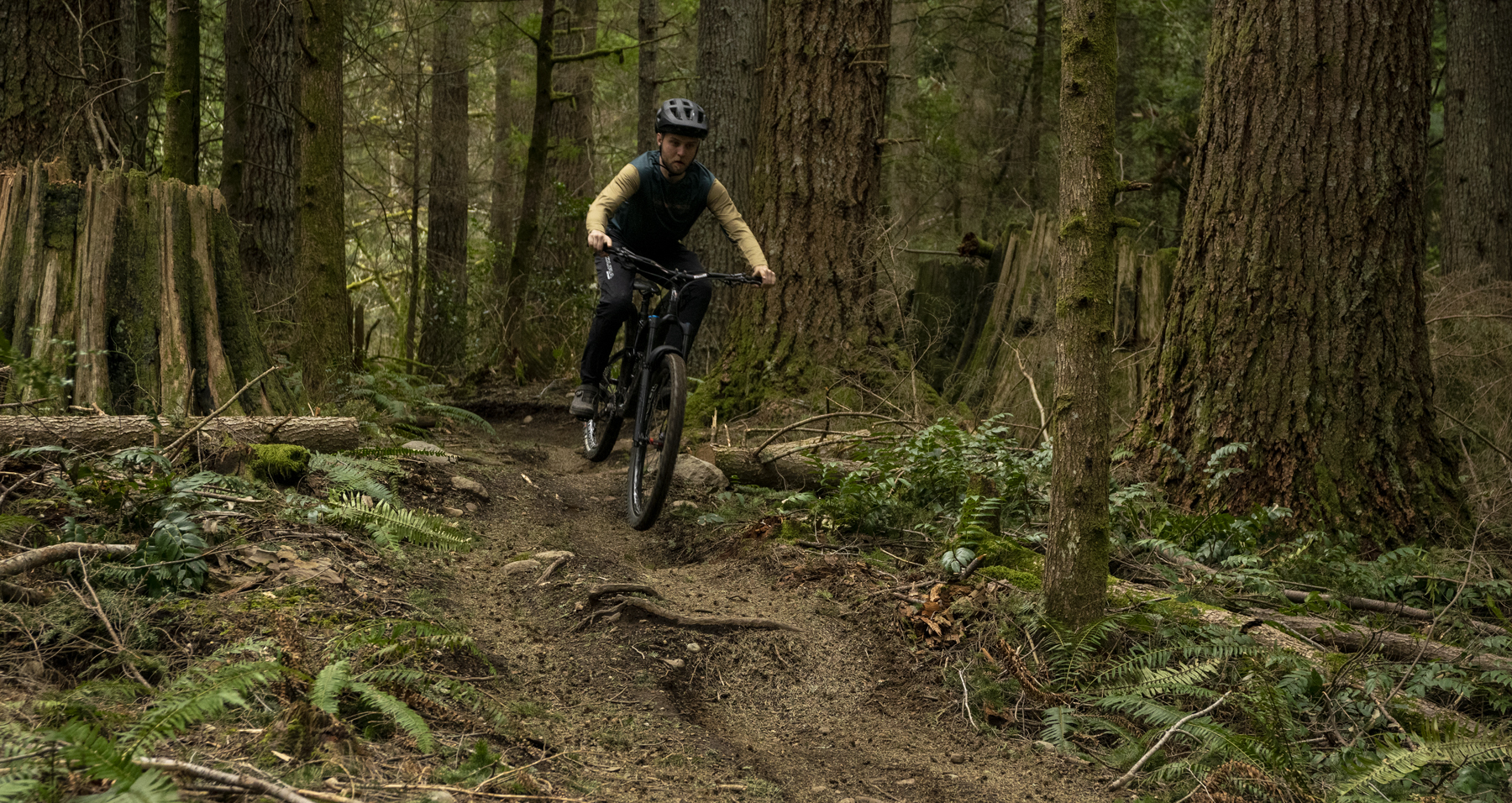
I also was emphatically not a fan of the one-piece Bontrager RSL bar and stem combo. It (arguably) looks cool and is very, very light, but the one-piece design means that there’s no way to adjust the handlebar roll and thus the effective sweep, and I found the angles of the stock setup to be quite uncomfortable. Granted, bar roll / sweep is a thing that I think I’m probably unusually picky about, but it really didn’t work for me. Happily, swapping in a conventional bar and stem is easy (and is something that I wind up doing on a lot of review bikes — like I said, I’m picky), but the one-piece design limits adjustability and I think is going to cause more folks problems there than conventional designs.
The in-frame storage on the Fuel EX generally works fine, but the opening isn’t all that big and it’s a bit hard to stuff larger stuff (e.g., a light jacket) in there. It also gave me what has to be the funniest noise issue I’ve ever encountered on a review bike. The Fuel EX that I tested had been ridden prior to getting sent our way, and when I started spending time on it, there was a muffled but noticeable rattle coming from somewhere around the downtube or bottom bracket area. As it turns out, it was a dried-out and quite-hard strawberry gummy that was rattling around in the bottom bracket shell after escaping whatever some previous rider had it stored in.

I don’t think there’s a big moral to the story here, other than to keep whatever you put in your downtube storage in some sort of pouch, whether it’s the included one or a different option of your choosing. In this case, it was mostly just amusing. The only real (but very minor) build quality note I’ve got is that the upper downtube protector started to sag a bit after a little while and looked a little ragged, but that’s hardly the end of the world.
I don’t mean for that to sound like a lot of complaining — overall, I think the build on the Fuel EX 9.8 XT is quite sensible, and generally a solid value for the money. Commenting on the couple of things where I saw room for improvement just feels a lot more noteworthy than rehashing that, yes, the Shimano XT drivetrain still works really well, etc. And while the Fuel EX 9.8 XT that I rode is a pretty good value for money, I think the 9.7 build might actually be the best bang-for-buck option in the line. On the 9.7, you get the same carbon frame, functionally very similar suspension (the Fox 36 Rhythm uses the older-generation chassis and is a little heavier than the newer 36 Performance on the 9.8 XT, but shares the same basic spring and damper design), and a slightly heavier but still strong-performing Shimano Deore / SLX / XT blend drivetrain. The loss of the carbon wheels is the biggest difference between the two at the end of the day, but for $1,550 in savings at retail price, I can live with that.
Comparisons
Here’s how the Fuel EX compares to several other bikes in its class. If you’re curious about other models, aren’t sure where to start in the first place, or have any other gear questions, you can Become a Blister Member , send us a message via the Member Clubhouse , and we’ll help you out one-on-one.
Trek Fuel EX Gen 5
I don’t have a ton of time on the prior-generation Fuel EX (which is still available from Trek, at least for the time being) but I’ve ridden one enough to know that the new sixth-generation version is pretty different. The new Fuel EX is much more stable and composed at speed, less nimble at low speeds in tight spots, and despite gaining 10 mm of suspension travel at both ends, probably pedals more efficiently. The new one is significantly “more” bike in most respects apart from pedaling efficiency.
Santa Cruz Hightower
This is one of the better comparisons here, but there are still some real differences. In the more middle-of-the-range geometry settings, the Fuel EX is a touch more stable at speed but a little less agile than the Hightower. The Fuel EX also pedals more efficiently but doesn’t offer quite as much traction under power.
But none of those differences are great enough to make them unreasonable bikes to cross-shop against each other or make it super cut-and-dried as to who should be on which bike, and they generally feel targeted at similar types of riding and use cases — just with slightly different characteristics. It’s also worth noting that their sizing breaks are a bit different, and there are likely going to be folks who simply fit one better than the other since, for example, the Large Fuel EX fits a little bigger than the Large Hightower.
Santa Cruz Bronson
Pretty different. The Fuel EX pedals a lot more efficiently than the Bronson but feels significantly less plush and cushy on the way back down. The gap in stability between the two isn’t as large as the differences in suspension performance might suggest, though the Bronson is still more bike on that front, too. And even with the Fuel EX set up as a mullet, the Bronson feels more oriented toward a riding style that favors slashing the rear end around and riding with more weight over the front end to facilitate that.
Transition Smuggler
This one’s interesting — the Smuggler and Fuel EX fit and handle pretty similarly, but feel quite different in terms of their suspension performance. The Smuggler feels much more supportive and lively whereas the Fuel EX is more plush and cushy, at the expense of some composure in really fast, rough sections (which, again, I think has more to do with the shock tune than anything to do with the frame itself). Despite the Fuel EX’s extra suspension travel, the two are pretty close in terms of pedaling performance and efficiency, though the Fuel EX definitely has an edge in terms of traction and grip under power.
Pretty different. These two are actually pretty close in terms of where they land on the super-quick handling to super-stable spectrum but differ substantially in a lot of other ways. The Ripmo has more suspension travel, and definitely feels like it — it’s more composed when plowing into rough sections of trail at speed, in particular. But its suspension also feels firmer and more supportive, as compared to the more plush and cushy Fuel EX. The Rimpo also has more of a notable preference for being ridden with a forward stance with some significant weight over the bars, whereas the Fuel EX feels happier being ridden more centered / neutrally, and has a bigger sweet spot in terms of body positioning — though I think some of that is driven by the fact that the Large Fuel EX fits just a bit bigger than the Large Ripmo we reviewed; the Fuel EX fits me better, personally, but that’s going to vary rider to rider.
Overall, the Ripmo feels like a bit more game-on, hard-charging bike whereas the Fuel EX is happier taking things easier, while still having a solid top end when you decide to open it up. In terms of pedaling efficiency, they’re not too far off from each other but I’d give a slight edge to the Fuel EX.
We Are One Arrival 152
Similar story to the Ripmo, but to a greater extent. The Arrival is a much more game-on, descending-focused bike than the Fuel EX and takes more speed and aggression to come alive, but rewards that sort of approach with an impressively stable, composed ride for a bike that’s pretty quick handling (again, when you’re on it and riding hard). The Arrival is also much more supportive and lively in its suspension performance, but less plush and cushy than the Fuel EX.
Orbea Occam LT
Also pretty different. Despite having 10 mm more rear wheel travel, the Occam LT pedals even better than the Fuel EX and feels especially sharp-handling and quick, whereas the Fuel EX is a little more stable at speed, especially in rougher terrain, but not as agile. The Fuel EX is also much more plush and forgiving in terms of its suspension performance at lower speeds but is far less nimble and pop-y than the Occam LT.
In terms of its handling and ride character, the Occam LT feels like a shorter-travel bike than it actually is, just one that’s got the extra compliance of a 150mm-travel bike when you really need it. The Fuel EX feels like “more” bike despite having a touch less suspension travel.
Orbea Rallon
The Rallon, on the other hand, is way more bike than the Fuel EX — more stable, more composed in rough sections, not as quick handling, and so on. It’s one of the most versatile, most efficient-pedaling Enduro bikes we’ve ever tested, but it still is a modern Enduro bike. The Rallon is impressively close to the Fuel EX in terms of pedaling efficiency, given that it’s got 20 mm of extra travel at each end, but the Fuel EX still wins out there. The two aren’t too far off from each other in terms of small-bump sensitivity, either, but the Fuel EX feels more plush and eager to use a lot of its travel at lower speeds and with mellower riding, whereas the Rallon is a lot more composed and supportive when you start hitting stuff harder.
The Fuel EX and Rallon do remind me of each other somewhat in terms of the way they fit and in the cornering styles they excel at most strongly — both are especially good when loading the bike up through the pedals, getting both wheels to grip hard, and carve through mid-speed, well-supported corners in particular — but the Rallon is much more bike in most respects.
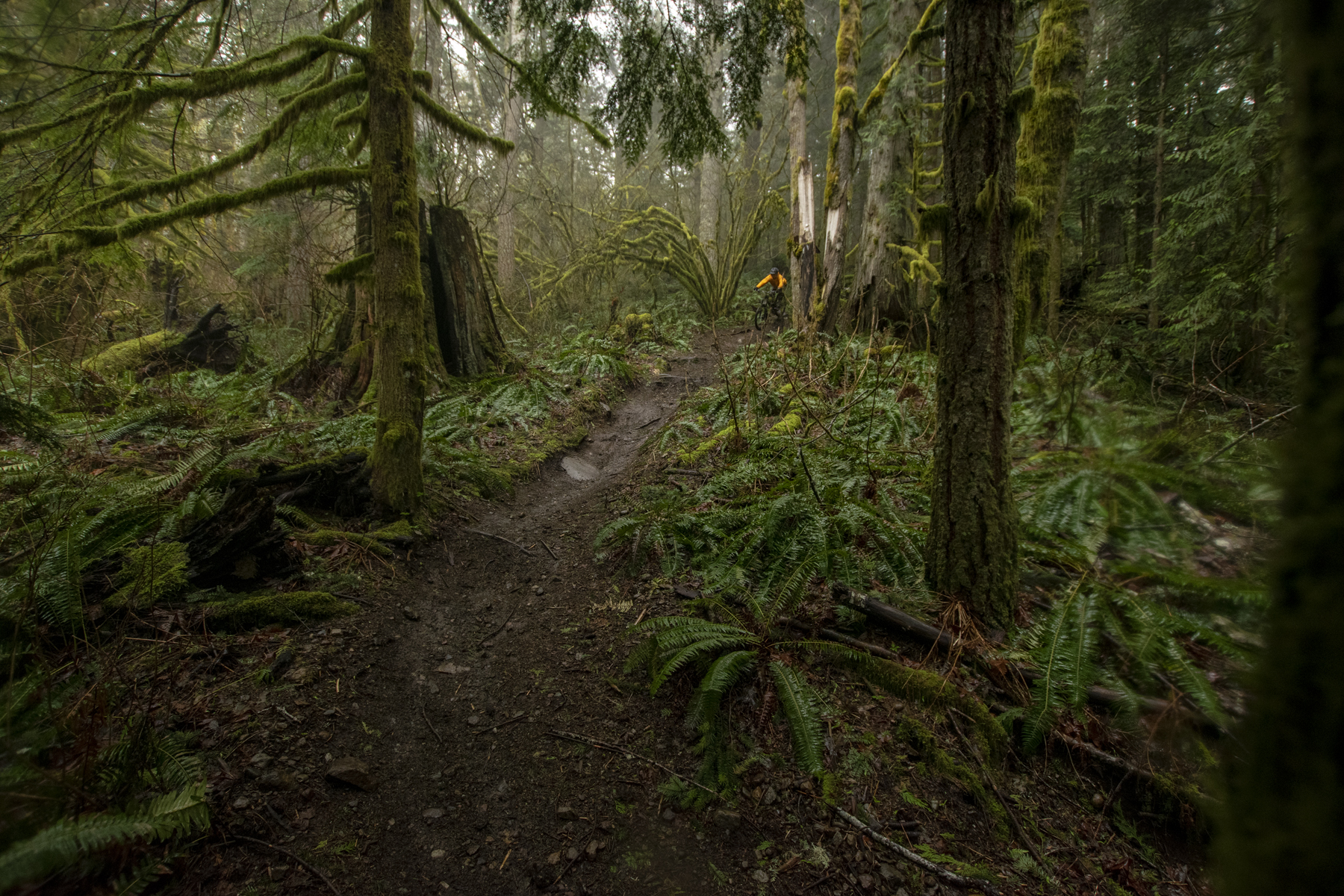
Who’s It For?
The new Fuel EX is an excellent all-rounder Trail bike, especially for people who favor a slightly softer, more supple suspension setup but still want a bike that pedals quite efficiently. It’s very versatile in terms its preferred riding style(s), has a big sweet spot in terms of body positioning and approach, and offers a really nice blend of solid stability and reasonably quick handling, plus a whole lot of adjustability to dial it in to your liking. Heavier and/or more aggressive riders might find the stock suspension tune to be somewhat lightly damped for their preferences — and I’d count myself among those people — but if you’d prefer a more plush, cushy ride, or are willing to put some work into getting the suspension tuned, there’s a lot to like here.
Bottom Line
The new Fuel EX is an especially well-rounded and versatile Trail bike that we can see working for a lot of different riders — especially since it has such a broad range of frame adjustments on offer. Riders who tend to favor firmer, more supportive compression tunes are likely to find the stock setup to be a bit lightly damped, but plenty of other folks are likely to appreciate the plush, smooth ride. And though I didn’t have the opportunity to test this hypothesis, I don’t think there’s anything inherent to the frame design that would stop folks who want a firmer compression tune from getting there via aftermarket tuning or a shock swap.
I want to be careful not to make too big a deal out of the shock tune — it wasn’t quite what I wanted, but I also definitely tend to prefer firmer, more supportive compression damping and I think that the stock setup will work great for a ton of people. And I really, really like the Fuel EX otherwise — it’s an impressively versatile bike that I was able to have a great time riding on a ton of different sorts of trails and one that I would be happy to take most places in the world as my one bike and not feel like I was missing out. And it’s one that I’ve already recommended to a bunch of Blister Members who’ve reached out looking for an all-rounder one-bike quiver, because the Fuel EX is a really good one.
2 comments on “2023 Trek Fuel EX”
Great review, did you manage to get the 200mm dropper in all the way? I am thinking of getting a 200 on my size large.
Yeah, pretty easily. I run a ~780 mm seat height (center of BB to top of the seat, on 170 mm cranks).
Trek has a good seatpost insertion guide in the service manual on their site. It is worth noting that the aluminum frames have a little less insertion than the carbon ones — 265 mm vs. 281 mm for the size Large of both.
Leave a Comment Cancel reply

Trek Fuel Ex 5 Review and Buying Guide

- Latest Posts
- Trek Fuel Ex 5 Review and Buying Guide - September 12, 2022
- Best Trek Mountain Bikes - September 12, 2022
- Best Marin Mountain Bikes: Which Model is Right for You? - September 12, 2022
High value, high performance, and impressive versatility– those are three features many would love to see in a mountain trail bike. But does Trek Fuel Ex 5 hold up to its marketing in a review– or are there better options?
Trail mountain biking is nothing new. But in the past decade, trail mountain biking has steadily grown from a niche activity to one loved by many. You only need to look at 2020 mountain bike riding statistics to get a picture of just how impactful trail biking has become and what it means for many.
Trail riding is unsurprisingly the most popular of all types of mountain biking , including enduro, downhill , and more. In a survey, over 92 percent of cyclists participated in the trail ride, a little over 56 percent in enduro, and 30 percent in downhill in 2 years.
But what’s driving so many to hit the trails? Trail riding is the most accessible for new riders, requires less heavy-duty equipment, and poses a lower risk of injury vs something like downhill riding. Mountain biking of all forms is a means of exercise, exposure to fresh air, and enjoying the community.
But even though the survey also indicated mental health benefits– with over 92 percent of respondents saying cycling helps balance negative emotions–there remains a barrier. Mountain biking is expensive, and not everyone can afford the equipment. But even if you can, you don’t want to overspend– and you also want to find a bike that will provide a smooth, stable ride.
That’s why I want to look at Trek Fuel Ex 5 , a trail bike that claims to be of great value. This guide will tell you my selection criteria for finding the best trail bike and review how Trek Fuel Ex 5 compares.

Fuel EX 5 is a full-suspension trail bike that's ready to handle it all. The Fuel EX 5 hits the mark as a high-value, high-performance mountain bike with exceptional versatility.
Table of Contents
Main Pros and Cons Trek Fuel Ex 5
- High-Quality Hydraulic Brakes
- 140 mm Width Travel
- Quality Performance Saddle
- Fluid 12 Speed Gears
- Wide Range of Sizes
- Dropper Post
- Angled Straight Top Tube
- Heavy For Aluminum Frame
- Tires with Low TPI
- Single Drive Chain
- More Expensive Than Some Entry Trail Bikes
What is trail mountain biking?
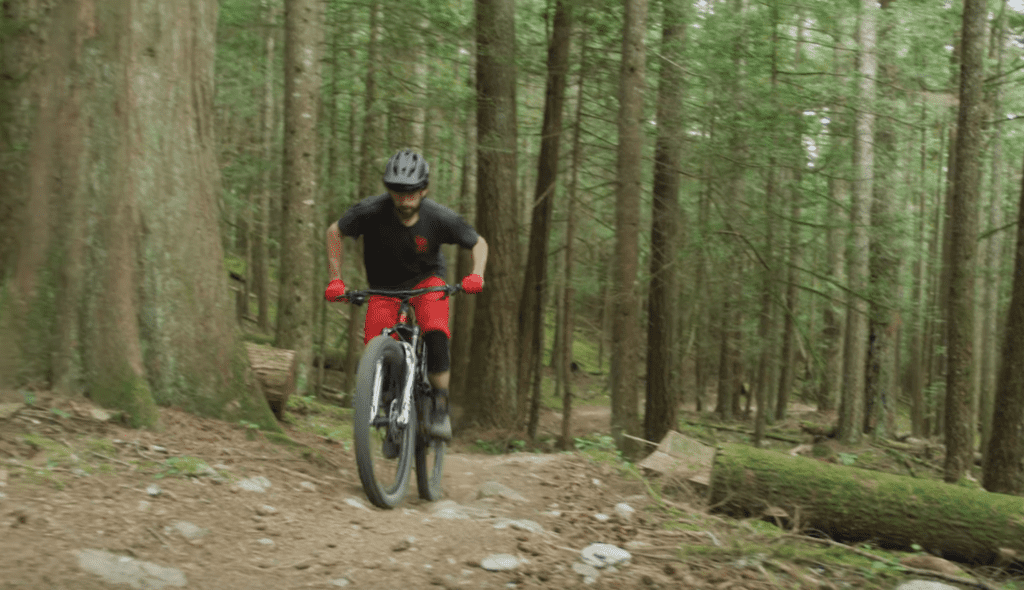
When you think about mountain biking, you may picture steep inclines and declines and even jumps. But in between that rigorous biking and road biking is trail mountain biking. Trail riding is a general term that encompasses off-road riding.
Dirt and grass path away from a hectic life. Unlike with road biking, you’re not going to encounter cars– though you could encounter other cyclists if you pick a popular TRS that are most common, and they may feature twists, turns, and inclines or declines– but that isn’t the main focus.
The concept of trail riding is providing timail. You’ll contend with various terrain, and trail mountain biking is more challenging in terms of technique and balance– but also slower than road cycling.
Is mountain biking a better workout than road biking?
Whether or not mountain biking is considered a better workout vs road biking, as you can imagine, is somewhat a matter of perspective. That is: how do you define a good workout? For some, it’s calories burnt. Others are worried about muscle gains or enjoyment.
All of these, and, of course, cardiovascular fitness, are valid factors. Mountain biking is more ideal for muscle development and a full-body workout. You’ll use more upper body strength, while road riding is mostly focused on lower legs and cardiovascular endurance.
You can cover more ground more quickly road cycling, but the ground you’re covering riding on trails is more challenging. Holistically, mountain biking is considered a slightly better workout– with the added advantage of scenic and quiet locations. Still, road biking can be an excellent workout if you enjoy it more or if that’s simply what you have access to.
Do I need a trail bike?
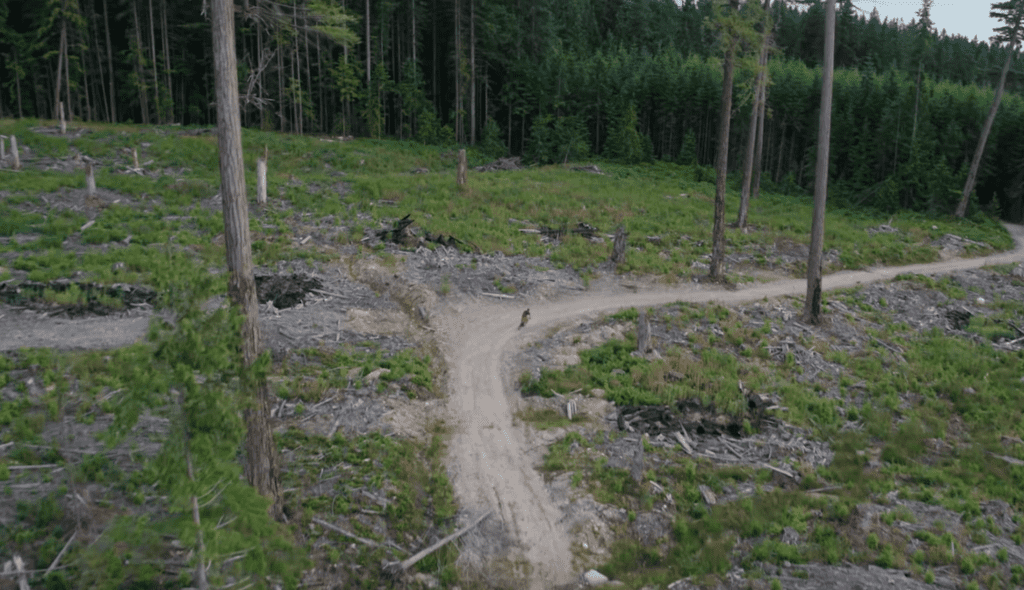
The first step is to assess whether or not you need a trail bike. Chances are if you’re considering a trail bike, it’s for good reason. If you already have a road bike it may be tempting to take it out on a trail- but that’s not a good idea. While bike categories may seem arbitrary, they exist for a reason.
Road bikes are typically made with a lightweight aluminum frame or other lightweight material, slim tires, and dropped geometry. A road bike is designed to reduce friction and optimize speed– so it’s not going to hold up well on uneven terrain. Road bikes simply don’t provide the traction and control you need for trail riding.
What is the difference between a trail bike and a mountain bike?
Mountain bike is an umbrella term for many types of bikes. A trail bike is a form of a mountain bike, so it’s a misnomer to say the two are different. So instead, I want to take a look at specific bike types and how they compare with a trail bike.
What is the difference between enduro and trail MTB?
Enduro mountain bikes are hardy bikes designed for downhill riding. They’re notable for their long travel and also accelerate at steep inclines. Enduro bikes are bulkier than general trail mountain bikes but are also more efficient, designed for trail racing competitions. You should get an enduro if you plan on racing or want to take on steep descents and inclines.
If you just want to ride recreationally on moderate trails, a trail bike will save you money, storage space and is a bit easier to learn how to ride. All-mountain bikes are included in the general category of enduro (which refers to racing), so the differences between trail and all-mountain bikes are the same as for enduro.
What’s the difference between a trail bike and a motocross bike?
Motocross bikes have a very specific purpose. These bikes are a form of a motorcycle and are ridden on muddy tracks with controlled conditions. Not only are they motor-operated, but they also feature bulky tires and handlebars and are bulky.
Dirt bikes are in between– nonmotorized bikes meant to tackle muddy conditions with knobby tires and a heavy frame. Trail bikes are far lighter and a bit more versatile, meant to tackle different trial types, and also designed for riding in fair to moderate conditions.
What’s the difference between XC and trail?
XC, or Cross Country , is a popular mountain bike type known for its versatility. XC bikes are ridden on trails and roads, making them a great crossover bike– though they’re more efficient on trails and not meant as a replacement for road bikes. It depends on the model you’re looking at.
Still, XC bikes are more lightweight and accelerate more easily than your average trail mountain bike. XC bikes are used for tortuous paths, but they’re not equipped for climbing or descending as much. XC bikes are used more for racing, while trail bikes are used for general rides and focus on control and greater shock absorption.
What is a trail bike good for?
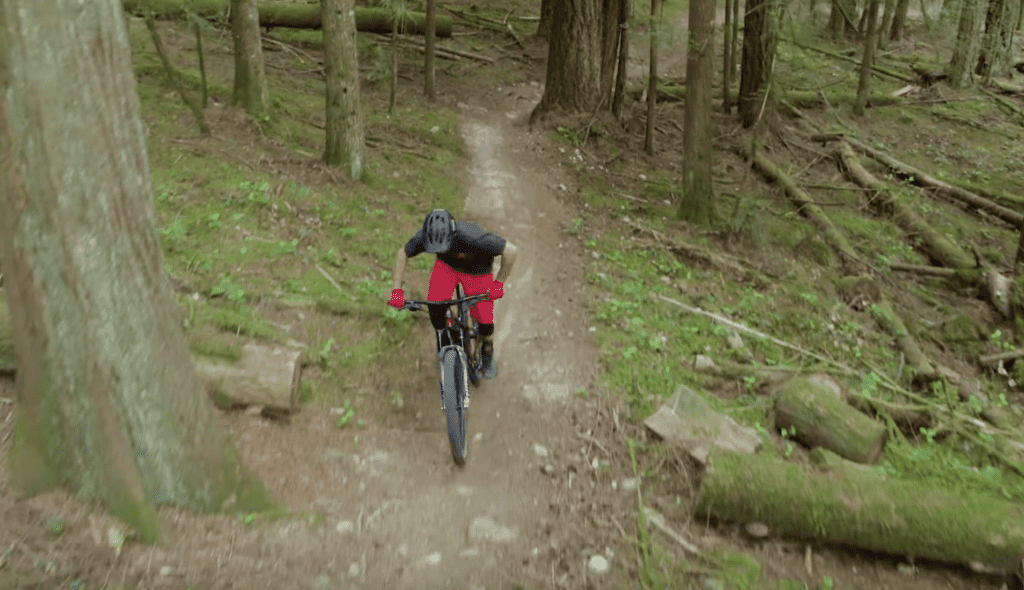
A trail bike is the most popular type of mountain bike for a good reason. It’s less specialized than other mountain bikes and can be used for most trails. Trail bikes can climb up or descend, though they aren’t intended for racing or especially steep inclines and declines or as inclement weather. Think of a trail bike as a recreational bike that’s harder than a road bike and offers more stability than a racing XC bike.
Can you jump a trail bike?
Technically you can jump just about any bike, but there are bikes designed for jumping. Trail bikes are not a great option for jumping, as they don’t have the acceleration and inertia to get much air. And while they offer control, that control isn’t designed for performing jumps. At most, you could do some modest jumping. If your main objective is to find a bike for jumps, I recommend a dirt bike.
Can I take a trail bike to a bike park?
While trail bikes are more versatile than some mountain bikes, they aren’t designed for road or bike parks. Trail bikes do perform at their best on trails.
Can you use a trail bike for downhill?
Trail bikes climb and descend efficiently. They offer control, but they’re not meant for the very steepest trails, nor are they designed for purely downhill biking. The key here is to understand that trail bikes value control over speed.
You can’t expect to do downhill racing, but a good trail bike can handle inclines and declines.
How do I choose a trail bike? ( My Buying Criteria)
If you’ve decided that a trail bike is the right type of bike for you, make sure that you find a bike that’s going to last and provide stability. Before I review Trek Fuel Ex 5, here’s a succinct guide to my selection criteria for finding a great trail bike.
What trail mountain bike size should I get?
Determining the right size is important for comfort and control, but it can also be tricky. Different brands have different sizing standards. Smaller frames or sizes may vary from manufacturer to manufacturer, so the best idea is to refer to that brand’s sizing guidelines. Click Here for Trek Mountain Bike Sizing .
How important is bike standover height and the top tubes?
Another sizing consideration is the standover height. A bike’s standover height refers to the length of the top tube to the ground and most commonly included within sizing information. This is important and also can lead to a better fit.
A standover height that’s too great can risk injury, while a too short height can leave you feeling cramped. For straight handlebars, I recommend an inch to two inches of clearance
. This provides a good fit and proper visibility. A sign a bike is too small is if you’re sitting on the bike and easily able to touch the ground with your feet.
Is a 27.5 or 29er tire better for a trail bike?
For the tire size, your most common options are a 27.5 vs a 29er. Both are fine, but I mean more towards a 29er for a trail bike. A 27.5 tire is generally more efficient at accelerating, but a 29er is going to provide a bit more traction and control.
But size isn’t the only factor in finding the best tire type. A dual compound improves durability. You’ll want a tread pattern that offers grip and traction for turning corners and some sidewall support. Puncture resistance is ideal for trail riding too.
What material is best for trail cycling?
You’ll have an option of aluminum, carbon, steel, and titanium for most mountain bikes. Of these, I’d recommend carbon the most for a trail bike. While titanium is a bit smoother and lasts just as long, it does get quite pricey, and may not be necessary for a trail bike.
Carbon is lightweight and, unlike steel, not prone to corrosion. Aluminum is attractive for being lightweight and budget-friendly– but I’d prefer aluminum for something like a road bike, as it’s more prone to damage.
How many gears should a trail bike have?
Considering that mountain bikes can have up to 40 gears, it can feel like you need as many gears as possible, but that’s not the case. For a solid trail bike, I recommend around 20-27 gears.
This provides more control and versatility- needed for trail riding– but doesn’t require you to search long and hard and pay top dollar. Aside from the number of gears, also pay attention to the type of gears.
You’ll also have the option between single, double, and triple drivetrains.
Of these, I recommend a double drivetrain. It’s a nice balance for a trail bike. You’ll have situations where you may need more than a single, but you also aren’t using a trail bike the same way you would an enduro bike.
Are disc brakes better on a trail mountain bike?
Between disc brakes and rim brakes, I recommend disc brakes for trail bikes. They’re smoother, more reliable, and less likely to become damaged when riding on trails. Some even consider a bike on a trail without disc brakes to pose safety hazards– I’d consider this feature nonnegotiable.
But you will need to decide between mechanical vs hydraulic brakes. Hydraulic brakes use fluid for stopping power, while mechanical brakes are purely based upon traditional brake chain force. Hydraulic brakes tend to be smoother and more expensive, and they’re quicker to respond.
I prefer hydraulic brakes for a trail bike, especially if you get caught in inclement weather. That doesn’t mean mechanical brakes are bad– they’re just not as efficient.
Is a hardtail mountain bike good for trails?
Full suspension tech is better for a trail bike if you have the money, though you can argue it’s not a must-have. With the full suspension, you’ll get both rear and front shock, equipping the bike with greater traction, steering control and making for a more comfortable ride for bumpy trails
. You’re adding weight and cost, but for many, those trade-offs are well worth it, especially since trail bikes aren’t intended for racing and quick acceleration. With a hardtail, you have a rear shock and a lighter setup. If you opt for a hardtail bike, I recommend sticking to even trails. If you’re doing fairly light trail riding, a hardtail may be just fine.
How much travel do you need for trail riding?
Bike travel is measured to determine the distance from the front or rear suspension that will absorb force. Thus, the greater the travel, the more shock resistance.
Bikes with greater travel may not accelerate as quickly, but they provide a smoother, more controlled ride for uneven trails. 100mm is the minimum I’d go, but 120mm to 130mm is a great range.
Above 140mm isn’t necessary for a general suspension trail bike.
How much is a trail bike?
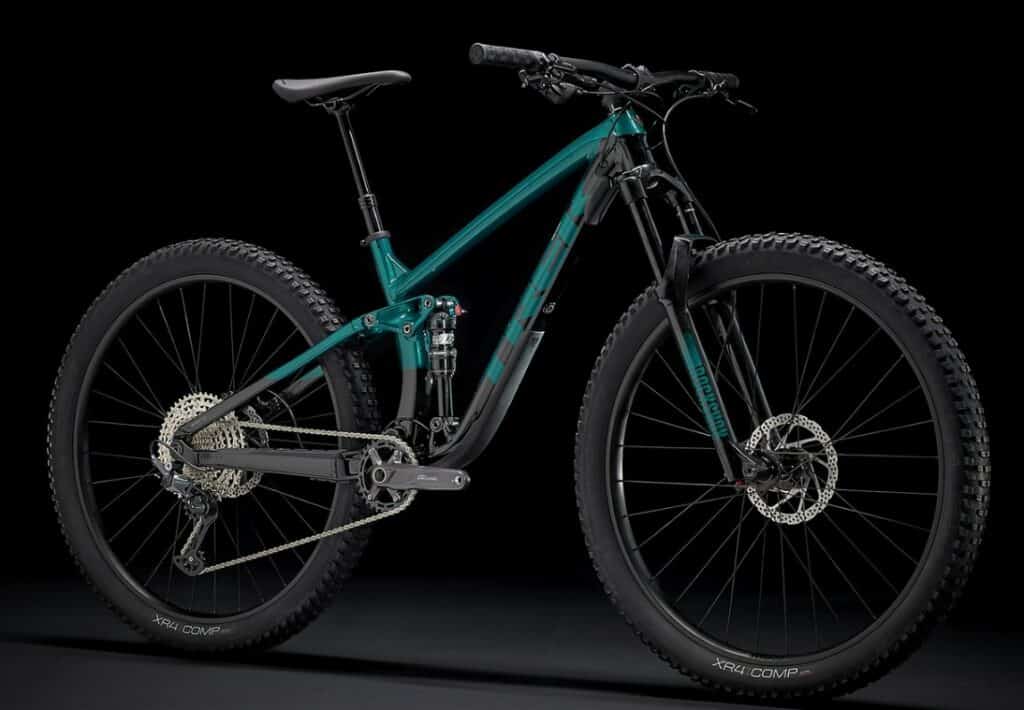
As you can imagine, the price of a trail bike ranges depending on materials, construction and brand. Trail bikes are more expensive than road bikes, but they’re also less expensive than something like an enduro bike.
You’re unlikely to find a trail bike that quality features for under $1,500, but spending a bit more leaves room for some great upgrades.
Are dropper seatposts worth it?
Dropper posts are sometimes used for mountain bikes to provide greater adjustments than your Seatpost. This can provide greater visibility and comfort, and for some avid cyclists, it’s worth it. However, for a trail mountain bike, it’s not usually necessary.
How do I choose the right mountain trail bike seat?
There is no perfect saddle for a trail bike seat, as we all have different bodies and different personal preferences. There are three general categories for mountain bike saddles: performance, racing, and recreation.
Since trail bikes aren’t used for racing, opt for a recreation saddle, or a performance saddle if you like a little versatility. You’ll want some cushioning and shock absorption, with gel offering the best cushioning and foam second.
A synthetic material like nylon that’s weather-resistant is wise for a trail bike. A center cut-out will provide a lighter profile and some breathability. Still, a saddle without a cut-out has more overall cushioning.
What is Trek known for?
Now that you know my criteria for finding the best trail bike, I want to examine Trek as a brand. If you’ve considered buying a mountain bike before, chances are you’ve heard the Trek name, and for a good reason. Trek is one of the most popular makes for mountain bikes of all kinds.
Trek is also known for its wide selection of entry-level bikes, which some competing brands don’t offer to the same extent. That is of course tied to the fact that Trek is the largest US-based cycling company. The Roth Distributing Company owns Trek.
Where are Treks made?
Up until 2017, Trek bikes were all manufactured and shipped from Waterloo, Wisconsin. Now they outsource some of their manufacturing to Asian countries, so none of their bikes are fully made in the United States.
Is Trek a good movie?
Trek retains its reputation as a solid brand for entry-level and more specialized mountain bikes. One way they’ve done so is by staying on top of new biking technologies while still offering bikes at an accessible range of prices. Their diverse inventory and willingness to improvise both highlights why Trek bikes remain well regarded and popular.
How long does a Trek bike last?
Trek bikes don’t all last the same time because that depends on the materials used and how heavily the bike is used. There’s so much variability– for all brands– for these and other factors that it can be difficult to estimate.
While most Trek bikes are well made, you’re not guaranteed that a bike will last a certain length of time. Regular bike maintenance is critical for whatever model you purchase.
Is the Trek Fuel Ex 5 Worth It?
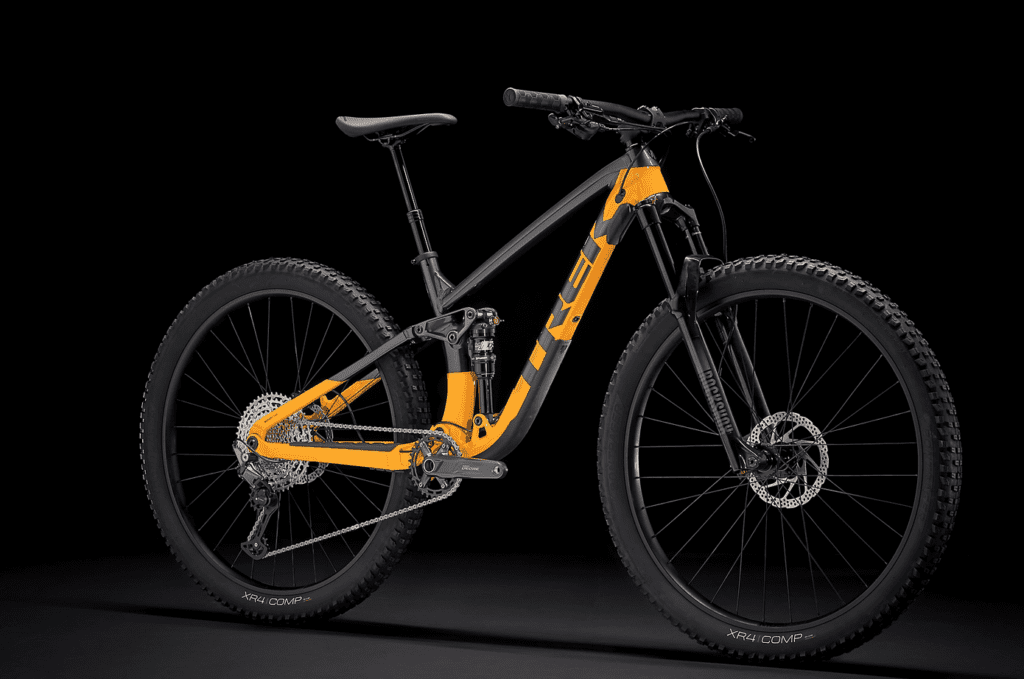
Trek Fuel Ex 5 is a striking but approachable bike, marketed as a high-value and high-performing option. With a dropper post and other great features, is it all hype or worth your money?
What type of bike is the Fuel Ex 5?
The Fuel Ex 5 is a mountain trail bike equipped with a blend of higher-end and accessible materials and features. It’s touted as a gateway to a mountain bike. The wording makes me think that the Fuel Ex 5 is trying to cater to those new to mountain or trail biking, or perhaps those who want great features but not at an eye-watering price point.
How much does a Trek Fuel Ex 5 cost?
Still, the price is higher than some trail bikes by a good $1,000, so it’s important to investigate every feature offered. Prices are subject to change and vary based upon your make and specifications. Still, you’re looking at spending roughly $2,500 as of the end of 2021/ early 2022.
What material is the Trek Fuel Ex 5 made out of?
The Trek Fuel Ex 5 features a lightweight aluminum frame, which surprised me for a few reasons. For one, at the price point, I expected perhaps a carbon fiber frame. But it also is a little heavy for its make.
Aluminum isn’t a terrible choice if you’re starting suspension trail riding. It is reasonable for moderate trails– but it can dent and become damaged by impact and debris. I do appreciate that aluminum won’t easily rust.

How much does a Trek Fuel Ex 5 weigh?
The Trek Fuel Ex 5 comes in at 34 pounds and 6 ounces for medium frame size. This is interesting because the average weight for a full suspension trail bike with an aluminum body is between 29 and 33 pounds.
This makes the Trek Fuel Ex 5 a bit heavy for what you’d expect, especially considering it’s not a full-suspension bike. I would argue this isn’t the biggest problem for a trail bike, but it still should be noted.
Your ride will feel a little less springy than you might expect from an aluminum body.
How much travel does a Trek Fuel Ex 5 have?
Here’s where the Trek Fuel Ex 5 shines: the travel. You get an impressive 140mm of travel, providing a smoother and more controlled ride. This is generous for a general trail bike, and an advantage over some competing bikes.
Does the Trek Fuel Ex 5 have a dropper post?
The Trek Fuel Ex 5 likewise has a dropper post. By opting for a dropper post, you’re getting more versatility out of your seat positioning, as well as offering a slight advantage for visibility. While not a must-have, it’s a nice feature to have if you know how to use it effectively.
What kind of drivetrain does the Trek Fuel Ex 5 have?
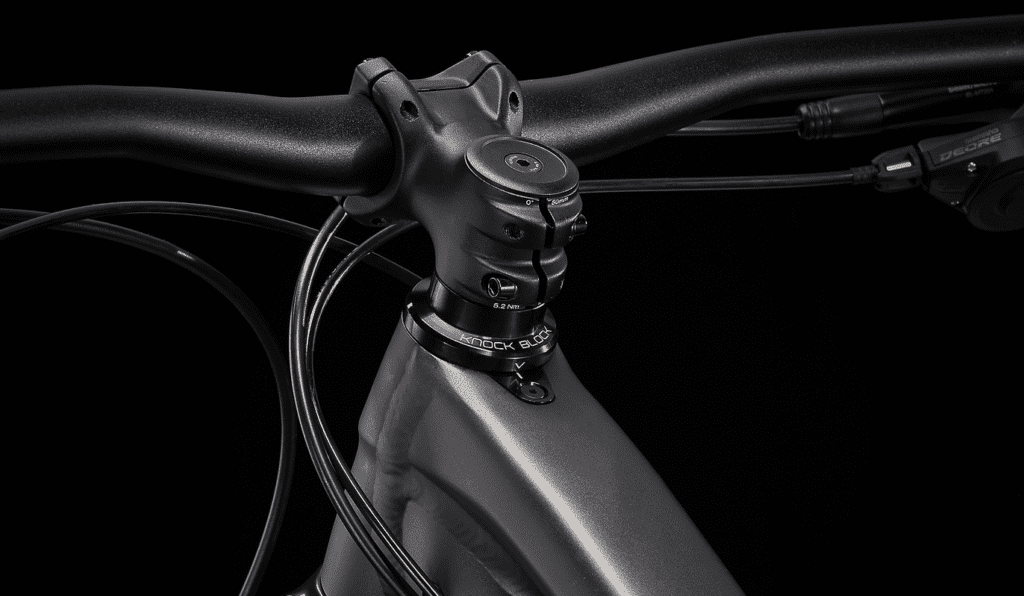
Trek Fuel Ex 5 has a Shimano 1×12 drivetrain. You’re getting 12 gear speeds and a single cassette. The 12 gears are sufficient for a trail bike for moderate trails, even if it’s not as generous as some models.
Shimano is a respectable brand and usually makes quality products. Their 12-speed drivetrain provides a stable and clean stop with new Hyperglide technology that’s meant to improve the single drivetrain experience.
For a single drivetrain, it’s a solid option, but I do wish they added a double drivetrain.
What type of brakes does Trek Fuel Ex 5 have?
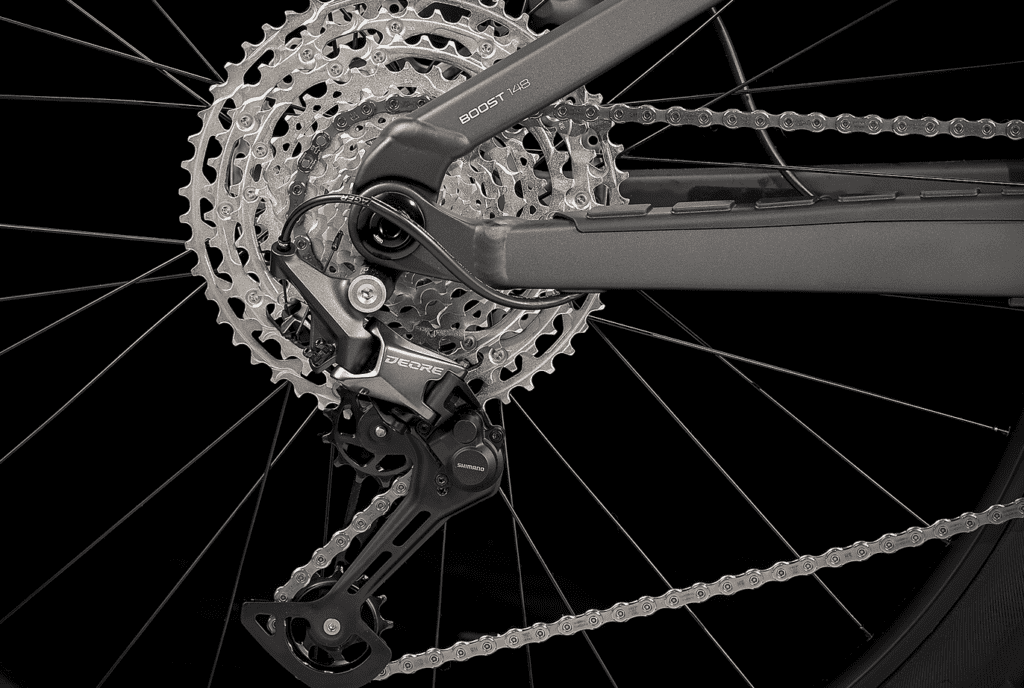
Hydraulic disc brakes are used for this model, which is a great upgrade for a mountain trail bike. The breaks are also manufactured by Shimano, which is another plus.
Is the saddle comfortable on the Trek Fuel Ex 5?
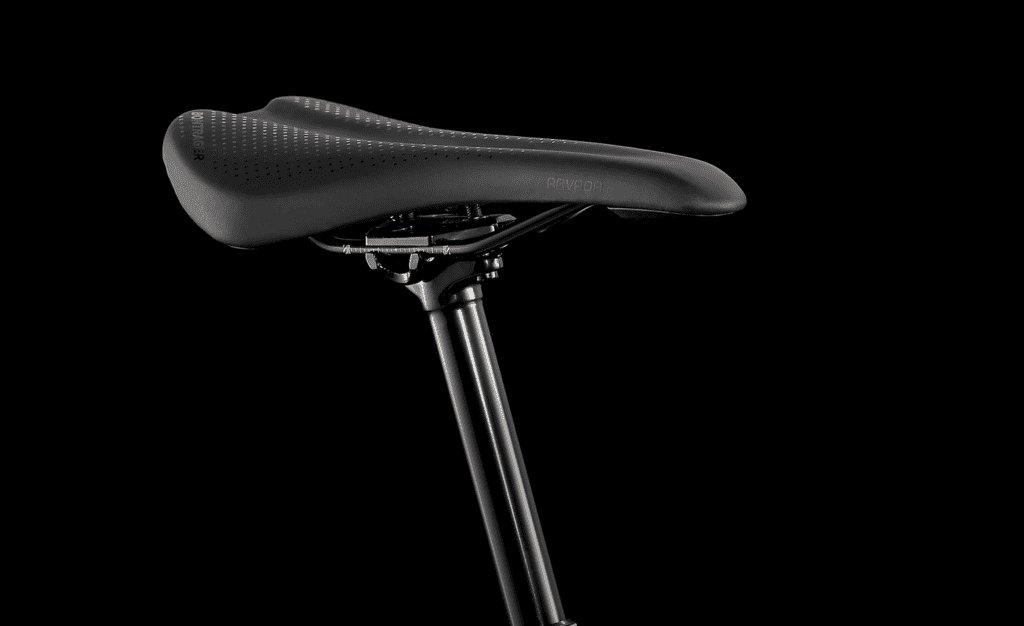
The saddle is a Bontrager Arvada . This is a performance saddle seen on both road and trail bikes and is made with microfiber. Microfiber is known to be lightweight and fairly durable. While it’s not fully weather-resistant, it can repel water.
The rail is made out of steel, which is strong but also can corrode over time. The cut-out is designed for pelvic rotation and is focused on balancing comfort and efficiency.
It’s a reasonable saddle choice– not a stand-out, but suitable for regular trail riding.

Arvada Comp adds comfort and reduces soft-tissue pressure by creating a strategic cut-out in the saddle shell.
What are the tires like for Trek Fuel Ex 5?
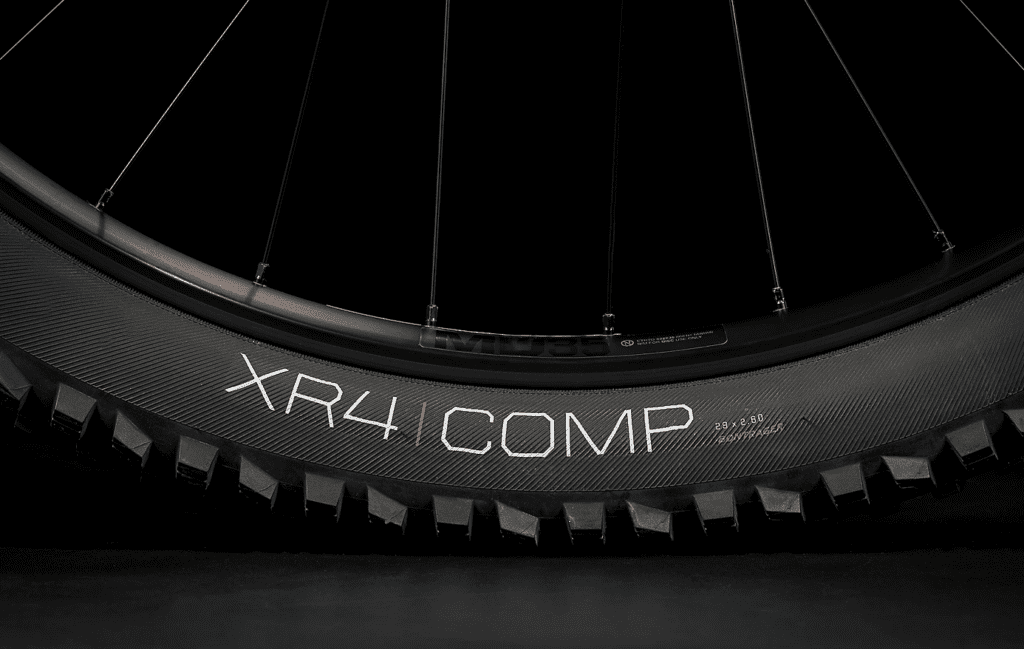
The tires are a 27.5” Bontrager XR4 Comp , with a 30 TPI. The size is designed a little more for acceleration than traction. 30 threads per inch for the tire is on the low end. Utility tires are around 15 tpi, while the high end may be 120 TPI.
For general trail riding, you want a tire that falls between 60 and 120 TPI, and it is always a trade-off and balance. The highest tapis has less rolling resistance, while the lower end is less likely to puncture.
If you do buy the Trek Fuel Ex 5, you may want to consider if you can swap out the tires for a bit higher tpi.

The XR4 Team Issue TLR tire offers incredible grip and fast-rolling efficiency in a new and improved tread pattern with 120 TPI casing. Save yourself from punctures with our Inner Strength sub-tread protection while squeezing out every bit of cornering traction with the 61a/50a dual-compound rubber.
Frequently Asked Questions
Answer: This depends on the model you’re considering. If you look at a newer model of both, you’ll be getting a carbon body with either bike. They also both feature full suspension for a general mountain bike. The main difference is that the Trek Fuel Ex 9.7 and the Top Fuel 9.7 are in the wheels, travel, and gear capabilities. The Top Fuel comes with either 27.5 or 29ers, while the Top Fuel Ex has 29ers and more gear capabilities. The Ex is better for a trail bike, while the Fuel could be argued for as an XC bike.
Answer: Ther Trek Fuel EX 9.8 features a carbon frame and weighs 28.94 pounds for a medium frame.
Answer: This Trek model is a versatile trail bike with a platinum aluminum frame and 150mm travel. It weighs 31.92 pounds for a medium frame.
Final Thoughts
The Trek Fuel Ex 5 has some great features going for it: hydraulic brakes, a dropper post, impressive travel, a respectable saddle, and well-designed gears. It is a bit limiting in other ways.
For example, an aluminum body frame but a heavier than average weight and low TPI tires make this bike a bit mixed in terms of features. It’s a decent bike for general light to moderate trail, and what’s here is mostly well done– I do wish it was a little cheaper.
Interested? Buy the Trek Fuel Ex 5 Here .
Final Buying Alternative
If you like Trek as a brand but are looking for an upgrade from the Trek Fuel Ex 5, consider the Slash 9.7. This trail mountain bike features a carbon frame, responsive 29ers, a tube guard to protect against damage, and a generous dropper and seat tube. Buy the Slash 9.7 Here .

Slash 9.7 pairs fast-rolling 29er mountain bike wheels with long travel suspension to make one speed-hungry rig that's perfectly suited to both rowdy trail rides and enduro races.
Leave a Comment Cancel Reply
Your email address will not be published. Required fields are marked *
This site uses Akismet to reduce spam. Learn how your comment data is processed .

MTB Insider Copyright 2022 | A Venture 4th Media company | Privacy Policy | Affiliate Disclosure | FTC Disclosure | About Us

2023 Trek Fuel EX 5 Gen 5 Bike

- Write Review
Specifications
Sizes and geometry.
trekbikes.com
More Products

2022 Sonder Cortex Deore Bike

2022 Jamis Faultline A1 Bike

2023 Orange Crush Bike

2022 On-One Wrekker SRAM GX Bike

2022 Commencal Meta TR 29 Origin Dark Slate Bike

2022 BMC Speedfox AL Two Bike

2023 Trek Top Fuel 5 Bike

2023 Rocky Mountain Element Alloy 10 Bike
- Mountain Bikes
- Trek Mountain Bikes
- Trek Fuel EX
- 2023 Trek Fuel EX

Most Popular

Hello Vital MTB Visitor,
We’re conducting a survey and would appreciate your input. Your answers will help Vital and the MTB industry better understand what riders like you want. Survey results will be used to recognize top brands. Make your voice heard!
Five lucky people will be selected at random to win a Vital MTB t-shirt.
Thanks in advance,
The Vital MTB Crew
Gear-obsessed editors choose every product we review. We may earn commission if you buy from a link. How we test gear.

Trek’s Fourth Generation Top Fuel Is the Pinnacle of Fast Trail Balance.
A mountain bike that does it all; yet may leave some riders asking for a bit more.
Builds, Prices, Claimed Weights
Ride impressions, notes from the field.

.css-uyz68u{display:-webkit-box;display:-webkit-flex;display:-ms-flexbox;display:flex;font-weight:inherit;font-style:inherit;-webkit-box-pack:start;-ms-flex-pack:start;-webkit-justify-content:flex-start;justify-content:flex-start;-webkit-align-items:center;-webkit-box-align:center;-ms-flex-align:center;align-items:center;cursor:pointer;scroll-margin-top:0rem;background-color:#ffffff;color:#000;width:100%;border:0;border-top:0.0625rem solid #E5E5E5;text-align:left;padding-top:0.3125rem;border-bottom:none;padding-bottom:0.3125rem;}@media(min-width: 64rem){.css-uyz68u{scroll-margin-top:3.375rem;}} .css-b4ahb2{border-radius:50%;width:1.875rem;border:thin solid #737373;height:1.875rem;padding:0.4rem;margin-right:0.625rem;} .css-jlx6sx{display:-webkit-inline-box;display:-webkit-inline-flex;display:-ms-inline-flexbox;display:inline-flex;width:0.9375rem;height:0.9375rem;margin-right:0.625rem;-webkit-transform:rotate(90deg);-moz-transform:rotate(90deg);-ms-transform:rotate(90deg);transform:rotate(90deg);-webkit-transition:-webkit-transform 250ms ease-in-out;transition:transform 250ms ease-in-out;} DETAILS click arrow to expand
Price as tested: $8,500 (X0 AXS) Weight as tested: 29.0 lb. (size ML) Sizes offered: S, M, ML, L, XL Model price range: $2,700 to $10,500 Frame only: Aluminum - $2,450, Carbon - $3,900 Fork travel: 130mm Frame travel: 120mm Recommended shock sag: 20-30% Frame tire clearance : 2.5” for 29” & 27.5 ” Bottom Bracket: BSA threaded Seatpost: 34.9mm Shock Dimensions: 185x50mm (stock), 185x55mm (optional), trunnion Piggyback shock compatible: Yes Coil shock compatible: Yes Derailleur Hanger: SRAM UDH Warranty: Lifetime frame warranty, two-year warranty on paint and bearings. Crash replacement: Trek’s Carbon Care policy offers a “significant discount to replace a damaged carbon fiber frame, fork, or part.”
The Top Fuel was Trek’s premier full-suspension XC race bike several years ago. But starting in 2019, Trek began to transform the Top Fuel into a lightweight trail bike, bumping up the travel and relaxing the geometry but keeping some XC-like features like a remote lockout.
The third generation Top Fuel was launched in 2021 with more travel—120mm rear travel and a 120mm fork—even more relaxed geometry, in-frame storage, and Trek eliminated the remote lockouts. But 2021 was also when some brands began to debut XC race bikes with 120mm travel and slacker geometry in response to rowdier courses. ( Scott’s Spark is a good example of this trend, as is the recently launched Specialized Epic 8 ).
Trek, however, went a different direction and positioned its 120mm bike as a light trail bike and debuted a new, shorter-travel full suspension Supercaliber for XC racing . And the third-generation Top Fuel quickly found itself in a sort of no-bike land. It was intended, designed, and equipped as not an XC race bike while XC race bikes from competitors arrived with travel and geometry similar to the Top Fuel.

In our 2021 review of the Top Fuel , my colleague Dan Chabanov, in addition to dinging the bike for being a bit heavy (compared to XC race bikes like the Spark), said, “Trek does say that the Top Fuel is compatible with a 130mm fork, and I can’t help but think the new Top Fuel would have made a lot more sense with the increased travel straight from the factory.”
Trek agreed, apparently, and after one model year, Trek began shipping the Top Fuel with a 130mm fork. This pushed it more into the trail bike category and helped place daylight between it and the new-school XC race bikes.
For the fourth-generation Top Fuel, Trek maintains the fast trail target. Trek retains the Top Fuel’s 120mm rear/130mm front travel while building in refinements to make the bike more dialed and broadly versatile.
Features and Details
The list of updates to the Top Fuel includes a significant frame-weight reduction. The aluminum and carbon frames are about 220 grams (almost a half-pound) lighter.
A weight reduction is always appreciated, and, built like for like, the new Gen 4 Top Fuel would be lighter than a Gen 3.
However, compared to the Gen 3 initially launched in 2021, Trek pushed the Top Fuel more into the trail category and added heavier components like longer travel, stiffer forks, and more aggressive tires. There’s also the added weight of SRAM’s Transmission compared to SRAM’s standard-mount-derailleur drivetrains.

As a result, even with the lighter frame, the Gen 4 Top Fuel’s overall bike weights are up compared to the Gen 3 Top Fuel that launched in 2021. According to Trek’s claimed weights, the lightest Gen 4 Top Fuel, the top-of-the-line 9.9 XX AXS model, weighs 28.3 pounds in a size medium: The Top Fuel we reviewed in 2021 in an extra-large weighed 26.8 pounds on our scale.
While it has gained weight due to its added capability, it is noteworthy that a Gen. 4 Top Fuel is three-plus pounds lighter than Trek’s longer-travel (140mm rear, 150mm front) Fuel EX . That alone should make it a more compelling trail bike option for many riders.
A striking detail buried in the tech information shared with the press was that the Trek product team made the new Top Fuel’s frame less stiff. Reducing stiffness from one generation to the next is not a typical move. However, it is possible to make a bike too stiff. And that has many drawbacks. In this case, Trek says that reducing stiffness makes the new frame “more balanced and forgiving” than the previous generation and helps reduce frame weight.
For many years, Trek’s mountain bikes have featured a geometry-adjusting flip chip called Mino Link, and some of its more recent mountain bikes have featured a flip chip that makes the suspension more or less progressive.
In the new Top Fuel, Trek combined the two flip chips into one four-position chip that alters geometry and progression (14 or 19 percent progression in this bike’s case). It is a feature likely to make its way into more Trek mountain bikes in the future.

On the theme of adjustments, Trek pitches several approved variations of the stock setup.
If 120mm rear travel isn’t enough for your needs, this Top Fuel will accept a 185x55mm shock (stock is 185x50mm), bumping wheel travel up 10mm to 130mm rear. To round out what would be a more gravity-oriented Top Fuel build, Trek officially sanctions the use of a 140mm travel fork and a 27.5-inch rear wheel for all sizes except the small. Small bikes run 27.5” wheels front and rear to give their riders “a more proportional fit and easier handling” and are not compatible with a 29-inch rear wheel.
But if you're more XC-oriented, the new Top Fuel is also officially approved for use with a 120mm travel fork. The brand says its top XC racers may use the Top Fuel with a 120mm fork and lightweight build instead of the shorter travel Supercaliber as courses and conditions merit.
Trek does not sell the Top Fuel as a complete bike in the 130/140mm gravity(ish) build or the 120/120mm XC build. Unfortunately, altering a stock 120mm rear, 130mm Top Fuel into either variant is not simple.
While the stock forks can be bumped up or down in travel with an air shaft, the swap requires tearing down and rebuilding the forks. In addition, the gravity build requires a new shock (the stock shock stroke cannot be increased), a new 27.5-inch rear wheel, and a new 27.5 tire. Based on my testing, a gravity-built Fuel EX will also need more powerful brakes. Riders who want the more XC-oriented Top Fuel will likely wish for lighter parts, particularly wheels and tires.

Because of these hurdles, I suspect that riders who definitively know they want either the XC or gravity-flavored Top Fuel are likely to buy a frame and build the bike from the ground up exactly how they want it. And here is a good place to mention that the Top Fuel is compatible with a wide range of shocks, including RockShox’s Flight Attendant, Fox’s Live Valve Neo automatic electronically controlled shocks, and even coil-over shocks.
But for all the riders who buy a complete Top Fuel, the option to morph it into a more XC or gravity-oriented bike is there, though it will be costly.
Rounding out the suspension updates, the new Top Fuel features a touch more anti-squat, which should make it feel slightly crisper when the rider pedals.
The in-frame storage gets a polish, with improved sealing, a larger opening in the down tube, and some refinements to the routing tubes so the storage bags slide in and out more easily.

Trek is also debuting improved bags for its in-frame storage. Previously, they had one neoprene bag for tube and tools. That one bag is replaced with two: One unpadded bag for a tube and one padded bag for tools (the padding reduces the chance of tools rattling against the frame). These new bags come with all 2025 Trek bikes with in-frame storage (carbon frames ship with both bags, aluminum frames only get the tool bag) and are also available for purchase.

And finally, Trek relegated the Gen 3 Top Fuel’s Knock Block steering stop system to the dustbin of history.
You’ll find frame geometry pasted here for your enjoyment. Trek sent me five different geometry tables, but I’m only pasting the one that details the complete bikes—120mm rear, 130mm front, flip chip in the low position, 29” x 29” wheels (size small has 27.5” x 27.5” wheels)— as they come out of the box.

Trek’s site will have all the variations, but essentially, changing the flip chip to the high position steepens the angles and raises the BB; swapping in a 140mm travel fork slackens the angles and raises the BB; and with a 27.5 rear wheel and 140mm fork, the bike has a 64.6-degree head angle, 342mm BB height, and effective seat tube angles that are about a degree slacker than the out-of-the-box geometry.
Adding a fifth frame size is the most significant geometry change from Gen 3 to Gen 4. Like some other Trek mountain bikes, the Top Fuel now has an ML frame size that fits between the medium and large.

Another notable change is the adoption of size-specific seat stay lengths. Sizes S and M have 435mm stays, ML and L run 440mm stays, and the XL gets 445mm stays (all sizes of the previous generation Top Fuel ran 435mm stays).
Many sizes get a seat tube angle adjustment: the small is half a degree steeper, the medium is 1.4 steeper, the large is 0.3 steeper, and the XL is 0.4 slacker.
Finally, the seat tubes are shorter—the XLs by a whopping 30mm—and there is more dropper post-insertion depth.

While Specialized tends to introduce its new bikes in high-end carbon versions, with lower-priced aluminum versions coming later , Trek, in its usual practice, is introducing its full line of Top Fuel models all at once.
The full range of seven models starts at $2,700 for the aluminum-framed Top Fuel 5 and ends at the $10k-plus 9.9 XX AXS with a carbon frame.
Regardless of price or frame material, all models have internal frame storage, fully guided hose-and-housing routing, a 12-speed drivetrain, tubeless-ready wheels and tires, lock-on grips, and a dropper post. All except the least expensive model have four-piston brakes (the Top Fuel 5 has two-piston hydraulic calipers).

Due to the late arrival of my test bike, I don’t yet have as much time on the new Top Fuel as I like before writing a review. But I’ve gotten in some good rides on some of my most familiar trails, so I feel I have a good sense of its performance and character. Even so, I will continue to ride it and update this review if my impressions change.
In the Notes From The Field section below, I’ve outlined my journey to a good fork setup, plus my feelings on the stock brakes. My impressions here are based on how the bike rides with the fork dialed in and a larger front rotor.
The 120 rear/130 front (ish) light trail category this Top Fuel resides in is lousy with amazing bikes. A quick list off the top of my head and in no particular order: Evil Following , Ibis Ripley, Pivot 429 Trail , Specialized Epic 8 Evo, Spot Ryve, Yeti SB120 , Giant Trance Advanced, and the Santa Cruz Tallboy.
That is some stiff competition, but I think Trek made a bike that competes well against this strong field.
The expectation for this style of bike is that it as fast on the climbs and flats as an XC bike and allows the rider to go full send on the descents like a trail bike. That is impossible. So, while everyone is seeking this holy grail of speed and capability in one, many bikes lean one way or the other. For example, the Epic Evo is more XC, while the Tallboy is more Trail.

The Top Fuel, however, feels more equalized. No, it doesn’t climb like an XC bike and descend like a trail bike—again, impossible—but it doesn’t seem to be lean one way or the other, like many of its competitors. It feels balanced: equal parts quick and capable.
That results in a handy bike, no matter the terrain or direction of the slope.
On smoother climbs, the suspension is quiet and efficient. There’s little unwanted motion, and upping the cadence is rewarded with eager thrusts. It is not as quick-feeling or firm at the pedals as some four-bar systems— dw-Link , most notably—but the Top Fuel is far from sluggish.
I will note that I ran the shock with 30 percent sag, the maximum Trek recommends. Traction is a challenge on many of my trails, so I usually prefer my suspension softer off the top. But the low end of the advisable sag range for this bike is 20 percent, and with less sag, the bike will feel more zippy.
But even with 30 percent sag, the rear end is supportive and holds the rider in a good position when the climb gets steeper. And when the climb gets chunky and technical, the rear end is sensitive and offers great traction.

On descents, the Top Fuel is composed and surprisingly confidence-inspiring, and I experienced little bucking or jarring deflections off my chosen line. Chunder, drops, jumps, gaps, and sketchy loose chutes: The Top Fuel telegraphed it was game for all of it. The rear suspension has a lovely tune that provides access to its full travel. It has plenty of bottom-out control and good sensitivity, too.
Nothing particularly stood out about the Top Fuel’s handling as I climbed and descended. It felt…normal, I guess? I wasn’t fighting the bike and didn’t feel I needed to adjust to work around any quirks.
It worked its way through my tightest, steepest climbing trails well. The Top Fuel handled downhill corners of all varieties intuitively. It flew true as an arrow on the fastest straightaways. I could change its direction at will and with little resistance. The bike felt like I could always position it exactly where I wanted and hit my lines accurately.
But for all of its impressively well-rounded performance, I didn’t sense an extra-strong “fun” vibe from the Top Fuel like I get from the Evil Following. In that way, Top Fuel perhaps lacks a little. It is so balanced that it is—while very far from boring—a rather staid bike.
I wonder if some of this is due to the bike’s weight. My ML size, XO AXS model weighs 29 pounds on my scale, which is only 1.2 pounds lighter than Specialized’s Stumpjumper 15 I recently reviewed. The SJ15 has more travel, more adjustments, a unique and fabulous rear shock, sticker tires, more powerful brakes, and is much better on descents and rough trails.
The Top Fuel does feel more lively, rolls faster, and is a bit quicker on climbs than the SJ. But some fast trail bikes like the Trek and the 29.4 lb. Yeti SB120 presents a conundrum because they’re not much lighter than bikes with the next jump up in travel.
To me, the deciding factor is feeling. Do you want a bike that feels snappier and climbs with a bit more pep, or do you emphasize descending speed and confidence? Personally, I prefer shorter-travel bikes. I like the snap and pep of less travel and to feel the trail under my tires. However, another large part of that preference is due to the shape of my trails. I can easily understand how a rider in a different locale would go for more travel.
Choices are good, but they can also be confusing. My best advice: if you're not sure what you want, borrow and demo as many different bikes and different travels as possible.
My time on the Top Fuel so far has left me with the impression that this Top Fuel is a superb bike that isn’t extraordinary. A bike I know will perform brilliantly on most trails, and I am happy to ride it, but it also leaves me wishing for something more from it, even though I can’t pinpoint what more I want.
Non-specific whinging aside, the fourth-generation Top Fuel is an excellent light trail bike that can compete with the best on the market.
Random observations and reports from my time testing the bike.
• I appreciate that Trek gave the Top Fuel internal storage AND a cargo mount under the top tube. Having both offers the rider more options for their preferred tube/tool/cargo setup. In my case, I put a (butyl) tube and flat repair kit with CO2 and Dynaplug Racer Pro inside the frame and used the cargo mount for an i nline OneUp EDC pump mount , which I fitted with the 70cc pump with an EDC tool inside.

• This Top Fuel offered my first chance to ride the Trek’s updated tire offerings. And they’re pretty good. The Gunnison front and Montrose rear tires offered predictable traction and seemed less flat-prone than the brand’s previous attempts. My trails are littered with tire-eating square-edged rocks, and I heard the familiar sound of a rim out several times while testing the Top Fuel. And though that sound made me mentally scramble to remember where I stashed Dynaplug, the flats, so far, haven’t happened. However, the compound does seem a bit biased towards fast rolling and does feel slightly slippery and bouncy on rock slabs and the hardest hardpack. But they seemed like a solid choice for this style of bike, and I didn’t want to tear them off after the first ride and throw on some of my favored Maxxis or Vittoria treads.
• When I pulled this bike out of the box to build it, I discovered one of the SRAM AXS pods had a dead coin cell battery. I’ve had a run of bikes with AXS pods that required a new coin cell after one or two rides. I don’t know if SRAM has a bunch of old batteries or a run of bad ones, but it’s annoying to discover your brand-new and nearly five-figure bike immediately needs a new battery.

• The SRAM Level Silver four-piston brakes, with 180mm HS2 rotors front and rear, are barely powerful enough for this bike. I realize that weight is a big deal in this bike category and that I am biased toward powerful brakes. But on the steeper trails, this bike is otherwise capable of riding my hands were aching from pulling on the levers so hard. I bumped up to a 200mm front rotor, which helped a lot (and I may yet go up to a 200mm rear). But if you’re considering this bike’s compatibility with longer stroke shock, 140mm fork, and 27.5 in. rear wheel, the stock brakes won’t cut it. You’ll want stoppers like Codes, TRP’s DHR Evo, or the Hayes Dominion.

• I usually don’t detail my suspension settings because I believe suspension settings result from terrain, trail surface conditions, riding style, and personal preference, so unless you are me and riding my trails, how I tune my suspension is irrelevant to you. In this case, however, I will detail a few of my fork settings because it took me a while to dial in this fork properly. The RockShox Pike on this bike has the brand’s recently revised air spring—increased negative spring volume, which softens the initial travel—and the revised Charger 3.1 damper, which has a greater damping adjustment range. Trek also ships this fork with no bottomless air tokens in the air chamber. With recommended pressure and zero tokens, the fork was an overly soft and unsupportive mess. I eventually wound up with two tokens in the fork and 95 psi in the spring, 15 over RockShox’s recommended pressure for my weight. Once the spring felt right, I found I liked the low-speed compression at -2 and the high-speed compression set at +1. This allowed me to add or subtract compression damping as trail conditions demanded.

A gear editor for his entire career, Matt’s journey to becoming a leading cycling tech journalist started in 1995, and he’s been at it ever since; likely riding more cycling equipment than anyone on the planet along the way. Previous to his time with Bicycling , Matt worked in bike shops as a service manager, mechanic, and sales person. Based in Durango, Colorado, he enjoys riding and testing any and all kinds of bikes, so you’re just as likely to see him on a road bike dressed in Lycra at a Tuesday night worlds ride as you are to find him dressed in a full face helmet and pads riding a bike park on an enduro bike. He doesn’t race often, but he’s game for anything; having entered road races, criteriums, trials competitions, dual slalom, downhill races, enduros, stage races, short track, time trials, and gran fondos. Next up on his to-do list: a multi day bikepacking trip, and an e-bike race.

.css-1t6om3g:before{width:1.75rem;height:1.75rem;margin:0 0.625rem -0.125rem 0;content:'';display:inline-block;-webkit-background-size:1.25rem;background-size:1.25rem;background-color:#F8D811;color:#000;background-repeat:no-repeat;-webkit-background-position:center;background-position:center;}.loaded .css-1t6om3g:before{background-image:url(/_assets/design-tokens/bicycling/static/images/chevron-design-element.c42d609.svg);} Member Exclusive

Beat the Heat with These Summer Cycling Kits

15 Fun Bike Events in the U.S.

6 Smart Low-Impact Exercises for Cyclists

Can Gaining Weight Make You a Better Cyclist?

What All the Tour de France Jersey Colors Mean

Lightweight Gear for Heavyweight Riders

The Best Mobility Exercises for Cyclists

All About E-Bike Tax Credits and Rebates

6 Benefits of Riding Outside

The Cheapest and Most Expensive Bikes at the TDF

How to Do These 5 Common Bicycle Repairs

- Forum Listing
- Marketplace
- Advanced Search
- Mountain Bike Manufacturer Forums
- Bike Manufacturers
Trek fuel ex 5 vs. Scott spark 960
- Add to quote
Tried finding a comparison for these two bike, but not a lot out there for the Scott (mostly others in the spark line). Hoping to buy one of these within the next few days, but am not sure which is the better bet. The trek is $1800 while the Scott is listed at $1900, but up until this weekend is at $1600. Just getting back into riding and am not really sure on which has the better components, and which I'll end up upgrading. Thanks,
If you are just getting back into riding, start with the Scott. It has less (more manageable) suspension travel, and if it costs less, then if it fits it will be your best choice.
IMO, don't waste your money with an EX5. It's such a baseline entry into the FS that it's not worth it. Go at least an EX6 and up.. As for Scott, couldn't tell you. Been seeing them more and more. I am considering one as my next bike. I demo'd a FS carbon model and loved it.
- ?
- 15.5M posts
- 520.3K members
Top Contributors this Month
First Ride | The 2025 Trek Top Fuel gets a new frame with adaptable travel, geometry & wheelsize
The not-so-minor details.
2025 Trek Top Fuel Gen 4
https://www.trekbikes.com
From $5,499 AUD ($8,999 AUD as tested)
- Snappy pedalling performance - Active suspension delivers grip both up and downhill - Sporty all-round handling - Adaptable travel, geometry & wheelsize - Practical frame design with plenty of protection & storage
- RSL handlebars are quite stiff once cut down to a reasonable width - SRAM Level brakes suffer from excessive dead stroke - Not the lightest bike in its category
Overhauled for 2025, the all-new Trek Top Fuel represents the 4th generation of the platform. Having started out as a pure XC race bike, the Top Fuel has evolved over the years with a steady increase in travel that’s broadened its capability and versatility. Nowadays it slots right in between the latest Supercaliber and the Fuel EX , occupying a hazy middle ground that could be considered ‘long travel XC’ or ‘lightweight trail’, depending on your perspective.
Blurring the lines even further, the latest Top Fuel boasts more adjustability thanks to its redesigned frame and clever 4-position Mino Link. With the ability to adapt the wheelsize, geometry and suspension travel, this could very well be one of the most versatile XC bikes out there.

An overview of the 2025 Trek Top Fuel
For 2025 the Trek Top Fuel receives an entirely new frame from tip-to-tail. Not that you’d really tell at first glance, with the overall shape and layout remaining much the same as the bike we reviewed back in 2021 .
Look a bit closer however, and you’ll see that every tube has been slimmed down to improve compliance and reduce weight. According to Trek the new Top Fuel frame is about 100g lighter than its predecessor, coming in at a claimed 2.6kg for the carbon frame including shock.
It still isn’t super-light, but it’s worth acknowledging that unlike some of its competitors that utilise flex-stays, the Top Fuel features a genuine four-bar suspension platform. The ABP design locates the most rearward pivot concentrically to the axle, which is said to mitigate the influence of braking on the suspension. To maximise sensitivity further, the one-piece rocker link drives the trunnion-mounted shock via cartridge bearings.

Compared to the previous kinematic the new Top Fuel is slightly more progressive and it has a touch more anti-squat. It otherwise retains its 120mm of rear travel and it comes from the factory with a 130mm travel fork. You’ll find 29in wheels fitted to all frame sizes except the Small, which is purpose-built around 27.5in wheels front and rear.
With those kind of numbers, the Top Fuel is going up against fellow XC bikes including the Specialized Epic EVO , Scott Spark , Pivot Trail 429 and the Giant Trance 29 .
New 4-way adjustability
Where things get a little more interesting with the new Trek Top Fuel is its unique 4-position Mino Link. Located at the lower shock mount, this flip chip offers a High/Low geometry setting that modifies the angles by 0.5° and changes the BB height by 6mm.

You can also flip the chip forwards and backwards to change the suspension’s leverage rate. It comes set up in the forward position to deliver 14% progression, though orienting it rearwards will increase progression to 19% to provide more ramp-up at the end of the stroke.
Furthermore, you’re able to modify the amount of rear travel. While the Top Fuel is built around a 185x50mm shock, it’s possible to increase the stroke to 55mm and boost rear travel to 130mm.
Given the frame is rated for use with a 120-140mm travel fork, this introduces some interesting setup options. You could configure it as a lightweight XC bike with 120/120mm of travel, or as a burlier trail bike with 140/130mm of travel.
You can even set up the Top Fuel as a mullet with a 27.5in rear wheel. To keep the BB at a reasonable height, Trek recommends running the flip chip in the High position and extending the fork to 140mm of travel if you decide to go the mixed wheel route.

Refined internal storage
The new Top Fuel frame also ushers in updated downtube storage that features a larger opening. The hatch is said to have a tighter and more weatherproof seal, and the cables are tucked further out of the way to minimise snagging.
There are two new BITS bags that come with the carbon bikes; one specifically for tools and the other to carry a tube. If you’ve still got more gear to haul there’s an external accessory mount underneath the top tube.
Trek has maintained a practical approach throughout, with the Top Fuel mercifully avoiding the industry trend for routing its cables through the headset. It also ditches the Knock Block headset, but you’ll still find a good ol’ fashioned threaded BB, bolt-on downtube armour, a rubberised chainstay protector and a removable thru-axle lever.

Trek Top Fuel geometry & size chart
There have been few changes to the geometry on the new Trek Top Fuel. The 65.5° head angle is carried over, and the reach is pretty much unchanged across the five frame sizes.
The effective seat tube angle ranges from 75.2-76.9°. It’s worth pointing out that Trek lists this angle based on a specific saddle height for each size, which is great to see.
Another noteworthy update is the introduction of size-specific rear centre lengths, which vary from 435mm on the smaller frames and go up to 445mm on the X-Large.
Dropper post insertion has also improved thanks to a straightened seat tube. With the exception of the Small, each Top Fuel will come with a 170mm travel dropper post, which is fashionably long for an XC bike.

Trek Top Fuel price & specs
There will be five Trek Top Fuel models coming into Australia this year. Prices will start at $5,499 AUD for the Top Fuel 8, which is the only model with an alloy frame.
All the others are built around an OCLV carbon frame and RockShox Deluxe Ultimate RCT shock. Bontrager finishing kit is used throughout, which includes a snazzy one-piece RSL cockpit and brand new Gunnison and Montrose tyres. You can see detailed specs and pricing on the full range at the bottom of this review.
The bike we have on test sits one step up from the bottom-of-the-range. It’s the Top Fuel 9.8 GX AXS, which we reckon offers the best bang-for-buck out of the lineup.

2025 Trek Top Fuel 9.8 GX AXS
- Frame | OCLV Carbon, ABP Suspension Design, 120mm Travel
- Fork | RockShox Pike Select+, Charger 3.1 RC2 Damper, 130mm Travel
- Shock | RockShox Deluxe Ultimate, RCT Damper, 185x50mm
- Wheels | Bontrager Line Comp 30, Alloy Rims, 30mm Inner Width
- Tyres | Bontrager Gunnison RSL XT 2.4in Front & Montrose RSL XT 2.4in Rear
- Drivetrain | SRAM GX Eagle AXS Transmission 1×12 w/30T Crankset & 10-52T Cassette
- Brakes | SRAM Level Bronze 4-Piston
- Bar | Bontrager RSL Integrated, Carbon, 27.5mm Rise, 820mm Width
- Stem | Bontrager RSL Integrated, Carbon, 45mm Length
- Seatpost | Bontrager Line Dropper, 34.9mm Diameter, Travel: 100mm (S), 170mm (M-XL)
- Claimed Weight | 13.2kg
- Actual Weight | 13.14kg
- RRP | $8,999 AUD

Sizing & fit
At 174cm tall I’ve been riding a Medium size in the Trek Top Fuel. It features a 447mm reach, which suits me just fine. Personally I wouldn’t want to go up to the M/L size, but it’s great to have that option available for riders in the 173-180cm height range who feel like they’re on the cusp between a Medium and Large.
The riding position is on the racier side, with the short head tube and near-77° seat angle pushing your weight forward and low. I haven’t found it to be uncomfortable, but it’s certainly not an upright cruiser like the Fuel EX. I can imagine that with a lightweight 120mm fork fitted up front the Top Fuel would be well suited for XC and marathon racing duties.
While the Bontrager contact points are fine, the RSL handlebar is laughably wide at 820mm. That might be ok for much taller and broader folks on an XL, but I’m not sure who else is running such wide bars on a XC bike. I promptly cut them down to my preferred width of 760mm, which effectively makes the bars stiffer by reducing the available flex. I much prefer the approach with the Race Face Era handlebars that are offered in three specific widths to avoid that issue.

Suspension setup
To start out I went with 30% sag for the rear suspension on the Trek Top Fuel. Setup is made easy thanks to anodised gradients on the shock, and there’s also the RockShox Trailhead app for suggested pressures and rebound settings.
I’m currently running 135psi to support my 67kg riding weight and have the rebound damping on the quicker side at 7/10 clicks.
The Deluxe RCT shock incorporates a two-position lever that provides you with Open and Pedal modes. There’s also a blue three-position dial for adjusting the low-speed compression damping in the Open mode. Set it in the ‘-‘ position for a plusher feel, or dial it towards ‘+’ to firm up the rear end.

Having already had a fair bit of experience with the 2025 RockShox Pike and the new Charger 3.1 damper, I knew I’d need more pressure than what’s suggested in the Trailhead app. 10% extra seems to be about right, which works out to be 70psi for me. I’ve also added a Bottomless Token for additional end-stroke support since the Pike’s updated DebonAir+ spring is considerably more linear than the pre-2025 version.
I’ve set the fork’s rebound dial on the faster side (12/20 clicks) and have positioned both compression adjusters in middle of their tuning range for the time being.

Trek Top Fuel weight
Confirmed weight for our Trek Top Fuel 9.8 GX AXS test bike is 13.14kg with the tyres set up tubeless and without pedals.
It’s not as light as the previous generation Top Fuel we tested a couple of years ago, but then the new bike does come with a bigger Pike up front, a longer travel dropper post, and a heavier SRAM Transmission.
The Bontrager Line Comp 30 wheels are also on the heavy side (2,094g confirmed). These come fitted with thick plastic TLR rim strips and tubeless valves, providing a simple and secure tubeless interface. Thankfully the fit wasn’t as stupidly tight as the tyre/rim interface on the Supercaliber we reviewed last year.

This would be my first experience with the new generation Bontrager Gunnison and Montrose tyres, both of which feature a 2.4in width and a supple 120 TPI construction. They utilise the sturdier XT casing that incorporates full bead-to-bead and apex protection to reduce the chance of pinch-flats. That means they’re not the lightest with the Gunnison coming in at 967g and the Montrose at 1,004g.
As usual I fitted a CushCore XC insert in the rear wheel, and set pressures at 20psi up front and 22psi out back.
On the trail
I’ve only had limited time aboard the new Trek Top Fuel, so these are very much early impressions. Don’t fret however, as we’ll be following up this first ride article with a proper in-depth review and video in the near future.
Mind you, it only took a few pedal strokes to appreciate the Top Fuel’s efficient and responsive demeanour. It might be heavier than a dedicated short travel XC race bike, but it offers up impressively pert pedalling performance even with the shock’s low-speed compression dial set to the softest position. The rear end feels very much set-and-forget, with no real need to reach for the shock’s two-position lever.

Heading across rockier singletrack, the new bike is noticeably sprightlier and springier than its predecessor. It’s comfortable and nicely damped, aided by the supple tyres and alloy rims.
The suspension is also top-notch, delivering great sensitivity front and rear. The new Pike is quickly becoming one of my favourite trail forks, with a considerably plusher action compared to the previous version. Paired to the Deluxe RCT shock, the Top Fuel is a smooth operator despite its modest travel.
It seems to manage its travel well too, with plenty of progression out back. I’m yet to bottom out the shock despite there being no volume spacers inside and with the Mino Link positioned it the more linear setting.

On rougher descents I’ve been impressed at how active the rear end stays under braking, resulting in less scrabbling of the rear tyre across loose surfaces. This is a key advantage of a proper four-bar suspension platform over a single pivot flex-stay bike, with the Top Fuel providing more grip both up and downhill. Indeed it’s the way that it manages to balance this traction with its snappy pedalling manners that stands out on the trail.
Any downsides so far?
I’m yet to encounter any glaring issues with the new Trek Top Fuel, which has so far provided great all-round performance across technical XC singletrack.
I will say that the alloy wheels don’t feel overly responsive, which is likely due to a combination of weight and stiffness. While the Top Fuel’s steering is direct, there is some occasional lag between your hands and the front tyre.

We’re still unconvinced by the latest SRAM Level brakes, which suffer from a long lever throw that means you have to run the reach adjuster further out so they don’t contact the grips when you’re yanking on them. Being on the lighter side, the overall braking power is fine for me with the stock pads and 180mm Centerline rotors. However, those after more bite should consider upgrading to thicker HS2 rotors that will improve power while also reducing some of the lever’s dead stroke.
One other potential downside is that the Top Fuel will only fit a single bottle. This differs to the Spark and Epic EVO, both of which will accommodate two. It’s no bother for me, but may be an issue for some riders who prefer heading out on long rides without a hydration pack.

Flow’s Early Verdict
First impressions of the new 4th generation Trek Top Fuel are so far mostly positive. While it might look much the same as its predecessor, the lighter frame and refinements to the geometry and suspension design are noticeable on the trail. It feels enthusiastic and sporty to ride, offering up impressive pedal efficiency with loads of grip on tap.
The new 4-way Mino Link and up-stroke capability gives it a few nifty tricks up its sleeve, and I’m eager to explore some of the various setup options over the coming weeks. Given the snappy pedalling performance, I really like the idea of fitting a lighter wheelset and a 120mm travel RockShox SID to turn the Top Fuel into a more race-focussed XC bike. I’m also curious about extending the fork and shock travel and fitting a 27.5in rear wheel to morph it into a lightweight trail bike.
If there’s any particular setup you’d like to see, or any specific questions you want answered, as always let us know in the comments. I’ll endeavour to address those in our in-depth review and video, which we’ll have coming your way soon. Stay tuned!

2025 Trek Top Fuel 9.9 XX AXS
- Fork | RockShox Pike Ultimate, Charger 3.1 RC2 Damper, 130mm Travel
- Wheels | Bontrager Line Pro 30, Carbon Rims, 30mm Inner Width
- Drivetrain | SRAM XX SL Eagle AXS Transmission 1×12 w/30T Crankset & 10-52T Cassette
- Brakes | SRAM Level Ultimate 4-Piston
- Seatpost | RockShox Reverb AXS, 34.9mm Diameter, Travel: 100mm (S), 170mm (M-XL)
- Claimed Weight | 12.85kg
- RRP | $18,499 AUD

2025 Trek Top Fuel 9.9 X0 AXS
- Drivetrain | SRAM X0 Eagle AXS Transmission 1×12 w/30T Crankset & 10-52T Cassette
- Brakes | SRAM Level Silver 4-Piston
- Claimed Weight | 13.1kg
- RRP | $15,499 AUD

2025 Trek Top Fuel 9.8 XT
- Drivetrain | Shimano XT 1×12 w/30T Crankset & 10-51T Cassette
- Brakes | Shimano XT 4-Piston
- Claimed Weight | 13.45kg
- RRP | $10,599 AUD

2025 Trek Top Fuel 8
- Frame | Alpha Platinum Alloy, ABP Suspension Design, 120mm Travel
- Fork | Fox 34 Rhythm, GRIP Damper, 130mm Travel
- Shock | Fox Float DPS, 3-Position Damper, 185x50mm
- Tyres | Bontrager Gunnison Pro XR 2.4in Front & Montrose Pro XR 2.4in Rear
- Drivetrain | Shimano SLX/XT 1×12 w/30T Deore Crankset & 10-51T Cassette
- Brakes | Shimano Deore 4-Piston
- Bar | Bontrager Line, Alloy, 27.5mm Rise, 780mm Width
- Stem | Bontrager Elite, 45mm Length
- Claimed Weight | 14.58kg
- RRP | $5,499 AUD

ABOUT THE REVIEWER - Wil Barrett
Bendigo, Victoria
- Submit for Review
- Terms & Conditions
Enjoy reading this?
Get similar articles delivered directly to your inbox
- Rocky Mountain
- Specialized
- YT Industries
- Allied Cycle Works
- Black Market
- DALLINGRIDGE
- Diamondback
- Early Rider
- EVO Bicycles
- Growler Bikes
- Guerrilla Gravity
- iGO Electric
- Intense 951
- Juiced Bikes
- View all brands
- Production Privee
- Rad Power Bikes
- Rambo Bikes
- Riese & Müller
- Soul Fast E Bikes
- Spark Cycleworks
- State Bicycle Co.
- Structure Cycleworks
- Surface 604
- Van Nicholas
- Vintage Electric
- We Are One Composites

- Cross Country

- All Mountain
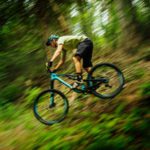
Trek Fuel EX 5
- AUS $ NZD $ USD $ CAD $ GBP £ EUR €
Weight / M - 15.55 kg / 34.29 lbs (with tubes)
At a glance
Where to buy.

"A world-class trail bike"
"Fuel EX is a beautifully balanced and capable trail bike. The rear suspension is beautiful; as close to ideal as any bike I've ridden. It's sensitive where you want it to be, firm and crisp where it should be. It feels deep and controls big hits very well, and there's a nice platform for pedaling, and to pump and pop off when you're playing."
"Good at pleasing everybody"
"Fuel EX has a few tricks that help it keep a level head when outside of its comfort zone, and to be a cloud on rails when it's in the zone. Everything about the Fuel EX, which was already good at pleasing everybody, is now even better at it."
"An absolute trail rocket"
"Thanks to its burlier components, increased travel, and more aggressive geometry, it has become more of a shredder than ever! More performance, fun, and trail prowess."
Specifications
- Frame Alpha Platinum Aluminum, tapered head tube, Knock Block, Control Freak internal routing, downtube guard, ISCG 05, magnesium rocker link, Mino Link, ABP, Boost148, 130mm travel
- Fork Size: XS , S RockShox Recon Silver, Solo Air spring, Motion Control damper, lockout, tapered steerer, 46mm offset, Boost110, Maxle Stealth, 140mm travel Size: S , M , ML , L , XL RockShox Recon Silver, Solo Air spring, Motion Control damper, lockout, tapered steerer, 42mm offset, Boost110, Maxle Stealth, 140mm travel
- Shock Size: XS , S X-Fusion Pro 2, 2-position damper, 210x52.5mm Size: S , M , ML , L , XL X-Fusion Pro 2, 2-position damper, 210x55mm
- Wheel Size 29" 27.5"
- Tires Size: XS , S Bontrager XR4 Comp, wire bead, 30 tpi, 27.5x2.60'' Size: S , M , ML , L , XL Bontrager XR4 Comp, wire bead, 30 tpi, 29x2.60''
- Chain Shimano Deore M6100, 12 speed
- Crank Size: XS , S Shimano MT511, 30T steel ring, Boost (52mm chainline), 170mm length Size: M , ML , L , XL Shimano MT511, 30T steel ring, Boost (52mm chainline), 175mm length
- Shifters Shimano Deore M6100, 12 speed
- Cassette Shimano Deore M6100, 10-51, 12 speed
- Brakeset Shimano hydraulic disc, MT201 lever, MT200 caliper
- Handlebar Bontrager alloy, 31.8mm, 15mm rise, 750mm width
- Saddle Bontrager Arvada, steel rails, 138mm width
- Seatpost Size: XS , S TranzX JD-YSP18, 100mm travel, internal routing, 31.6mm, 361mm length Size: M , ML , L , XL TranzX JD-YSP18, 130mm travel, internal routing, 31.6mm, 425mm length
- Headset Knock Block Integrated, 58-degree radius, cartridge bearing, 1-1/8'' top, 1.5'' bottom
Q: Where to buy a 2021 Trek Fuel EX 5?
The 2021 Trek Fuel EX 5 may be purchased directly from Trek .
Q: How much does a 2021 Trek Fuel EX 5 weigh?
A 2021 Trek Fuel EX 5 weights M - 15.55 kg / 34.29 lbs (with tubes).
Q: What size wheels does the 2021 Trek Fuel EX 5 have?
The 2021 Trek Fuel EX 5 has 29" and 27.5" wheels.
Q: What size 2021 Trek Fuel EX 5 should I get?
No comments on this bike yet. Why not be the first?
Leave a Reply Cancel reply
Your email address will not be published. Required fields are marked *
Want more MTB in your mailbox?
The latest on mountain bikes delivered straight to your mailbox.

More Bikes in Range View All

Trek Fuel EX 7
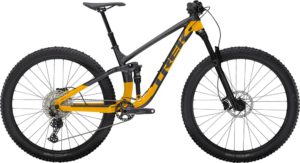
Trek Fuel EX 9.8 GX AXS
More trail bikes view all.

Niner RIP 9 RDO 27.5+ 4-Star XT
CVA suspension system, Internal and external dropper post routing, Electronic drivetrain wiring compatibilty (including integrated battery storage in the frame), Optional wheel upgrade: ENVE M60+ rims with DT Swiss 350…

Devinci Django Deore 12S
- Split Pivot suspension design - External cable routing - Geometry adjustable via flip chip in lower shock mount - Compatible with 27.5+ wheels/tires - Weight given for size MD

Specialized Enduro Comp SE 29
Deals view all, view all deals, recent posts view all.

Blackburn Honest Digital Pressure Gauge Review
It's 2020 people. The squeeze and bounce test doesn't cut it anymore (and this is…

Comparing Mountain Bikes
Mountain Bikes are complicated machines. They have parts from hundreds of different manufacturers, come in…
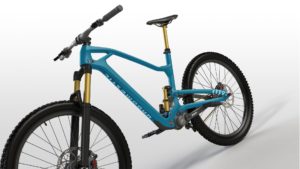
Undomestic Mountain Bikes: Here’s what we know
Update March 2020: Undomestic has announced that they are manufacturing frames "at this moment" and…
Send Feedback
Have a suggestion? Looking for a bike that's not on MTB Database? Or perhaps you've spotted an error?
We'd love to hear from you. Let us know with the form below.
This website uses cookies to ensure you get the best experience possible. Learn more.
About MTB Database
Explore, search and compare thousands of the world’s best mountain bikes here on Mountain Bike Database.
Compare prices, components, suspension, reviews, images and more on current and past MTB’s. You can even share reviews, comments and questions on mountain bikes. View and compare a huge selection of bikes from brands such as Trek , Specialized , Giant , Santa Cruz , Norco and more .
We strive to provide accurate and up-to-date information for mountain bikes on MTB Database. If you’ve spotted any issues, please let us know . We also include helpful tools, such as our frame size calculator, to assist you in choosing the right mountain bike. Bear in mind that these tools serve as a guide and simply provide a general indication. Refer to information provided by your bike manufacturer for the most applicable information for your bike.
Bikes By Brand
Bikes by year, bikes by riding style, bikes by wheel size, popular bikes.
- 2022 Specialized Epic EVO Comp
- 2022 Trek Marlin 6
- 2022 Specialized Enduro Comp
- 2022 Specialized S-Works Epic EVO
- 2022 Specialized Epic EVO Expert
- 2022 Giant Fathom 29 1
- 2022 Trek Marlin 7
Latest Bikes
- 2023 Commencal SUPREME DH V5 SIGNATURE 70'S
- 2023 Orange Phase 29 Factory
- 2022 Commencal META SX V4 TEAM Frame
- 2023 Commencal SUPREME DH V5 SIGNATURE LTD
- 2023 Commencal META SX V4 - Frame
- 2023 Riese & Müller Swing4 vario
- 2023 Riese & Müller Swing4 silent
- Election 2024
- Entertainment
- Photography
- AP Buyline Personal Finance
- AP Buyline Shopping
- Press Releases
- Israel-Hamas War
- Russia-Ukraine War
- Global elections
- Asia Pacific
- Latin America
- Middle East
- Election Results
- Delegate Tracker
- AP & Elections
- Auto Racing
- 2024 Paris Olympic Games
- Movie reviews
- Book reviews
- Financial Markets
- Business Highlights
- Financial wellness
- Artificial Intelligence
- Social Media
Russian passenger jet crashes flying empty near Moscow, killing its crew of 3
The Sukhoi Superjet 100 of Gazprom Avia that crashed near Moscow on Friday, July 12, 2024 takes off at Krasnodar International Airport outside Krasnodar, Russia, Saturday, July 10, 2021. The plane crashed while flying without passengers, killing its crew of three. Officials said it was heading to Moscow’s Vnukovo airport after repairs at an aircraft-making plant in Lukhovitsy 110 kilometers (68 miles) southeast of the Russian capital. (AP Photo/Alexander Lebedev)
FILE - A Russian passenger Sukhoi Superjet 100 plane performs during the MAKS-2019 International Aviation and Space Show in Zhukovsky, outside Moscow, Russia, Tuesday, Aug. 27, 2019. A Russian passenger jet crashed Friday, July 12, 2024, while flying without passengers, killing its crew of three, officials said. The Sukhoi Superjet 100 went down in the Moscow region, according to Russian emergency officials. (AP Photo/Pavel Golovkin, File)
- Copy Link copied
MOSCOW (AP) — A Russian passenger jet crashed Friday near Moscow while flying without passengers, killing its crew of three, officials said.
The Sukhoi Superjet 100 plummeted into a forest near the village of Apraksino about 90 kilometers (55 miles) southeast of the Russian capital, according to emergency officials.
The plane belonged to Gazprom avia, a carrier owned by the Russian state-controlled natural gas giant Gazprom .
Gazprom avia said the plane took off from an aircraft-making plant at Lukhovitsy 110 kilometers (68 miles) southeast of the Russian capital where it had undergone repairs. It was heading to Moscow’s Vnukovo airport when it crashed eight minutes after takeoff.
The cause of the crash wasn’t immediately known, but some Russian media reports indicated that both of the plane’s engines may have failed, probably because of birds getting into them on takeoff.
The Investigative Committee, the country’s top state criminal investigation agency, has launched a probe into the crash.
The Russian-made Superjet 100, also designated as SSJ100, was hailed by Russian officials as a major achievement for the country’s civil aviation industry when it went into service in 2011 but it has had a patchy safety record.
In May 2012, a Sukhoi Superjet 100 slammed into a dormant volcano during a demonstration flight in Indonesia, killing all 45 aboard. The investigation revealed that the crew was unaware of high ground and ignored signals from the terrain warning system while flying in thick clouds.
Another Superjet crashed at Moscow’s Sheremetyevo airport in May 2019, killing 41. It was struck by lightning and made an emergency landing shortly after takeoff. The probe blamed the pilot, concluding that he landed the plane heavy with unburned fuel at excessive speed, resulting in a rough touchdown that sparked a fire.
Ever since the plane has entered service it also has been dogged by malfunctions and high maintenance costs that have made many Russian carriers reluctant to buy it.
Russia’s ambitious attempts to widely market the plane abroad have largely failed, and the few foreign customers have phased Superjets out of service.
Top Fuel Gen 3 or Gen 4
See which is right for you
- filter controls Items 24 24 48 72 filter controls Sort by Relevance Relevance A-Z Z-A Price Low-High Price High-Low

IMAGES
VIDEO
COMMENTS
Fuel EX 5 Gen 5. 127 Reviews / Write a Review. $2,199.99 $2,699.99. Model 5260692. Retailer prices may vary depending on location and delivery method. The final price will be shown in your cart. Fuel EX 5 is a full-suspension trail bike that's ready to handle it all. With trail-taming 140mm front and 130mm rear suspension, a Shimano 1x12 ...
Fuel EX 5 is the gateway to full suspension trail bikes. A 140mm fork and 130mm of rear travel, a Shimano 1x10 drivetrain, a dropper post for getting low on descents, and Shimano hydraulic disc brakes make Fuel EX 5 a high-value, high-performance mountain bike with exceptional versatility. Compare. Color / Trek Black/Purple Lotus.
Fuel EX 5 is a full-suspension trail bike that's ready to handle it all. With 150mm front and 140mm rear trail-taming suspension, a Shimano 1x12 drivetrain, a dropper post for getting low on descents, and hydraulic disc brakes, Fuel EX 5 hits the mark as a high-value, high-performance mountain bike with exceptional versatility. Compare.
For the Fuel EX 5, Trek only offers two build options: a higher-end, 9.8 AXS Gen 5 and the budget-friendly EX 5 they sent us at $2,499. Leading the charge on our test bike was a Rockshox Recon Silver with the Motion Control damper and lockout. In the rear, there was a X-Fusion Pro 2 shock with "open" and "climb" positions.
The Fuel EX 5's frame is made from Trek's Alpha Platinum Aluminum with 130mm of rear-wheel travel using the Active Braking Pivot (ABP) suspension design. The 2020 Fuel models have seen some changes to this rear suspension design, mostly that they now use a fixed lower shock mount as opposed to the full-floater design of years past. The frame ...
The 2023 Trek Fuel EX 5 Gen 5 is the pinnacle of mountain biking performance with features designed to give riders unprecedented freedom and control on the trail. It features an aluminum frame with light and stiff geometry, as well as a dropper seat post for tackling big climbs, mountain descents, and off-road adventures with ease.
Dec 2022 · Mike Levy. The downtube storage compartment is on the new bike, and while it seems like Trek has put all the things onto the latest Fuel EX, there's one that they didn't: Knock Block. Highs. Wide range of effective geometry adjustments. Just as much fun on smooth trails as it is on scary trails.
Apr 2023 · Drew Rohde. While the new Trek Fuel EX may have alienated a few riders, it will no doubt be a welcome redesign for a lot more riders! Highs. Fast, confident and ready to rock! More capable than ever. Great downtube storage solution. Adjustable and versatile geometry options. Med/Large size.
The 2020 Trek Fuel EX 5 is an Trail Aluminium / Alloy mountain bike. It sports 29" and 27.5" wheels, is priced at $2,100 USD, has RockShox suspension and a Shimano drivetrain. The bike is part of Trek 's Fuel-Ex range of mountain bikes. Fuel EX 5 is the gateway to full suspension trail bikes. A 140mm fork and 130mm of rear travel, a Shimano 1× ...
A 140mm RockShox Recon Silver fork, 130mm of rear travel with an X-Fusion Pro 2 shock, a durable 12-speed Shimano Deore drivetrain, dropper post, and hydraulic disc brakes. The final word. You get full suspension performance without the sticker shock. Fuel EX 5 has the same frame technology as our higher-end alloy Fuel EX models with parts ...
The 2019 Trek Fuel EX 5 29 is an Trail Aluminium / Alloy mountain bike. It sports 29" wheels, is priced at $2,000 USD, comes in a range of sizes, including 15.5 in., 17.5 in., 18.5 in., 19.5 in., 21.5 in., has RockShox suspension and a Shimano drivetrain. The bike is part of Trek 's Fuel-Ex range of mountain bikes.
2023 Trek Fuel EX. Wheel Size: XS: 27.5''; Small: 27.5'' and 29'' options; M through XXL: 29''; all 29'' frames also mullet compatible with a 160mm-travel fork Travel: 140 mm rear / 150 mm front Material: Aluminum and carbon fiber versions available Sizes Offered: XS-XXL Price: Aluminum frame w/ Fox Float X Performance: $2,600; Carbon frame w/ Fox Float X Factory: $3,900
Fuel EX 5 is a full-suspension trail bike that's ready to handle it all. With trail-taming 140mm front and 130mm rear suspension, a Shimano 1x12 drivetrain, a dropper post for getting low on descents, and hydraulic disc brakes, the Fuel EX 5 hits the mark as a high-value, high-performance mountain bike with exceptional versatility. Compare.
The main difference is that the Trek Fuel Ex 9.7 and the Top Fuel 9.7 are in the wheels, travel, and gear capabilities. The Top Fuel comes with either 27.5 or 29ers, while the Top Fuel Ex has 29ers and more gear capabilities. The Ex is better for a trail bike, while the Fuel could be argued for as an XC bike.
34 lb 9.8 oz (15,700 g) Miscellaneous. • ABP (Active Braking Pivot) rear suspension design. • XS has 27.5" wheels, SM available with 27.5" or 29" wheels, MD-XL have 29" wheels. • Geometry adjustable via Mino Link flip chip in rear rocker link pivot. • Straight Shot frame design with Knock Block steerer stop.
49 posts · Joined 2018. #1 · Oct 5, 2022. The reviews for the new Trek Top Fuel are all very positive. (It's snappy, progressive, ect…) I'm looking at getting my wife a new bike and I have been comparing the Current Top Fuel to the Gen5 Fuel EX. To me they look pretty similar, but I don't remember so many positive comments about the ...
With this release, Trek has moved to size-specific chainstay lengths, ranging from 435mm up to 445mm for extra large frames. Pricing for the Trek Top Fuel 4 builds range from $3,999.99 to $10,499.99. It appears that frame-only options will be available for purchase as well. Check out all the builds and get more info on the Trek website.
While it has gained weight due to its added capability, it is noteworthy that a Gen. 4 Top Fuel is three-plus pounds lighter than Trek's longer-travel (140mm rear, 150mm front) Fuel EX. That ...
Trek fuel ex 5 vs. Scott spark 960. Tried finding a comparison for these two bike, but not a lot out there for the Scott (mostly others in the spark line). Hoping to buy one of these within the next few days, but am not sure which is the better bet. The trek is $1800 while the Scott is listed at $1900, but up until this weekend is at $1600.
Trek Top Fuel geometry & size chart. There have been few changes to the geometry on the new Trek Top Fuel. The 65.5° head angle is carried over, and the reach is pretty much unchanged across the five frame sizes. The effective seat tube angle ranges from 75.2-76.9°.
Our favorite Trek. Fuel EX proved itself a happy climber and descender. From slabs to roots and square-edge hits, the Fuel EX handled it masterfully. ... Fuel EX Gen 5 dishes out more nimble handling with less weight, along with better components for the price and internal storage on carbon models. • 130/140mm travel
2015 Trek Fuel EX 7 29er I bought this bike new and rode it sporadically over the years on Moscow mountain. Great trail bike that climbs super well. Has the coveted "full floater" rear suspension design. This would be an excellent bike for someone just getting into mountain biking or wanting to step up but not spend so much. This was $3k new.
Specs, reviews & prices for the 2021 Trek Fuel EX 5. Compare forks, shocks, wheels and other components on current and past MTBs. View and share reviews, comments and questions on mountain bikes. Huge selection of mountain bikes from brands such as Trek, Specialized, Giant, Santa Cruz, Norco and more.
There's a decent sale on Scott Sparks, which puts either the 970 or 960 in my price range and maybe the 950 if there was a really compelling reason to get it. There's also the Trek Top Fuel 5 and 7 (the 7 is a little more than I want to spend, but I could if I had to).
Ex-astronaut who died in Washington plane crash was doing a flyby near a friend's home, NTSB says In May 2012, a Sukhoi Superjet 100 slammed into a dormant volcano during a demonstration flight in Indonesia, killing all 45 aboard.
A screenshot from the livestream shows an image from the SpaceX Starlink satellite launch that took off on Thursday. The flight marked the first mission failure for a SpaceX Falcon 9 rocket in years.
Top Fuel AL Gen 3 Frame Set. R 40 000.00. Items. 24. Sort by. Relevance. Rule the trail with Top Fuel -- a downcountry bike built to hammer up and rip down every trail. Light, playful and ready to party. Shop online and in-store!